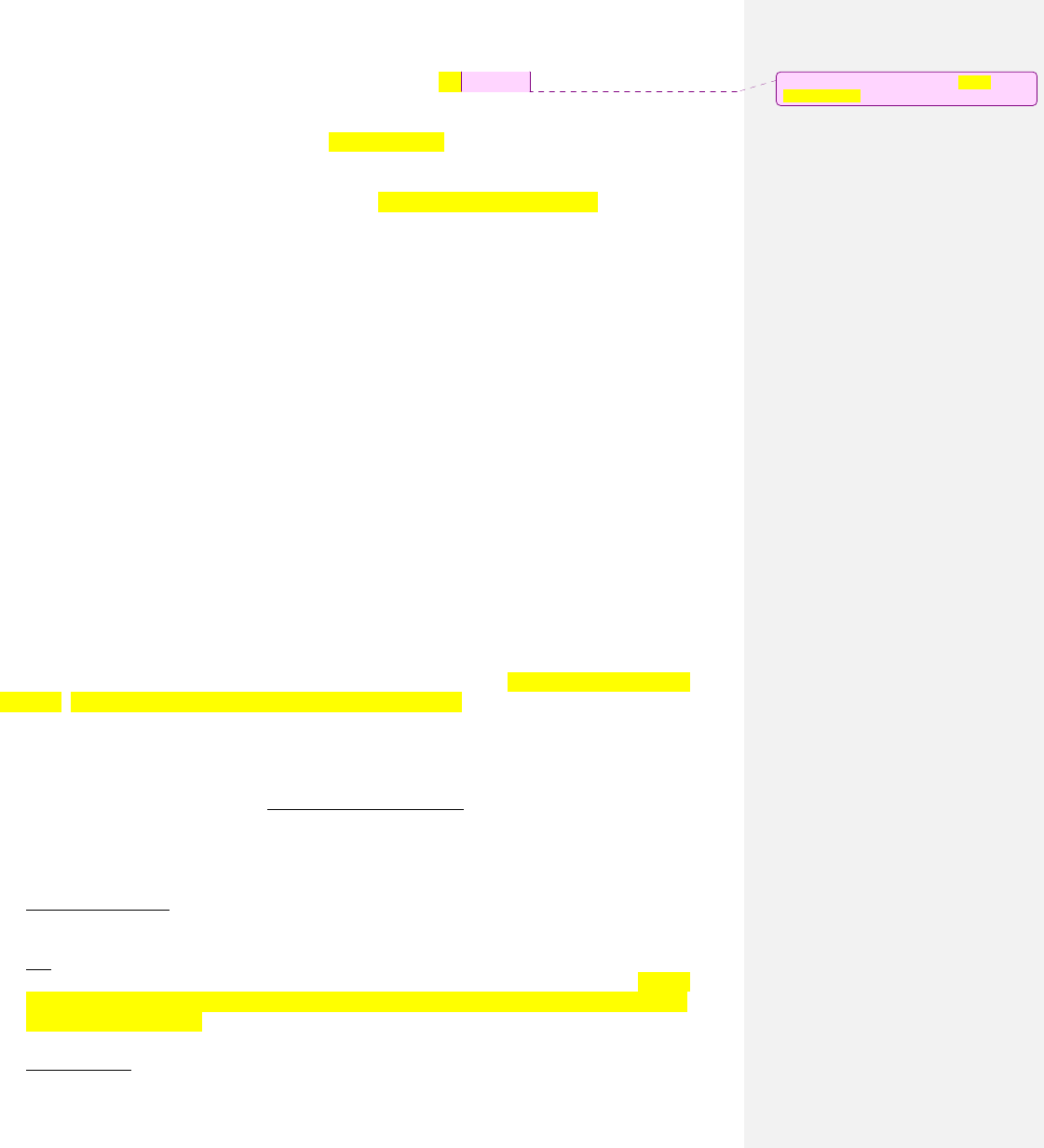
Rev 10/15/16
CONTRACT NUMBER 17-XXX-XX
AGREEMENT BETWEEN THE SOUTHERN CALIFORNIA ASSOCIATION OF GOVERNMENTS
AND CONSULTANT
THIS AGREEMENT, made and entered into, by and between the Southern California Association of
Governments, hereinafter referred to as “SCAG”, and [insert full name of Consultant], hereinafter
referred to as “Consultant,” and collectively referred to herein as the “Parties.”
RECITALS
WHEREAS, SCAG is a Joint Powers Agency and a federally designated Metropolitan Planning
Organization for Southern California. SCAG is primarily responsible for developing the regional
transportation plan and transportation improvement program for the counties of Los Angeles, Orange,
San Bernardino, Riverside, Ventura, and Imperial;
WHEREAS, pursuant to its annual Overall Work Program (OWP), SCAG will be engaged in many
activities and projects that will require certain technical, professional, or support services from time to
time;
WHEREAS, all obligations of SCAG under this Agreement are subject to the availability of Federal and
State funds and enactment of the State of California (“State”) Budget Act. Thus, no payments may be
made under this Agreement prior to the passage of the State Budget Act for any Fiscal Year;
WHEREAS, partial funds provided under this Agreement have been allocated pursuant to the State
Transportation Development Act (TDA) for the purpose of transportation planning, Cal. Util. Code
Section 99233.2(b)(2);
WHEREAS, SCAG’s Fiscal Year is from July 1 through June 30;
WHEREAS, SCAG seeks to retain the services of Consultant to provide [general description of the
services]; This Project is part of the SCAG Sustainability Program; and,
WHEREAS, Consultant agrees to perform the services required by SCAG on the terms and conditions
set forth below.
TERMS OF AGREEMENT
NOW, THEREFORE, for good and valuable consideration, the receipt and adequacy of which are
hereby acknowledged, the Parties hereby agree as follows:
1. Agreement Contents
This Agreement is comprised of these terms and conditions and any attached exhibits. Such terms
and conditions are subject to change in the event requirements are changed by SCAG’s funding
agencies. The Recitals to this Agreement are also incorporated herein by this reference. [If the
source of funding is other than CPG (e.g., FAA), add references to appropriate grants, etc., and
incorporate by reference]
2. Scope of Work
Comment [N1]:
SCAG will fill in yellow
highlighted text prior to contract execution.
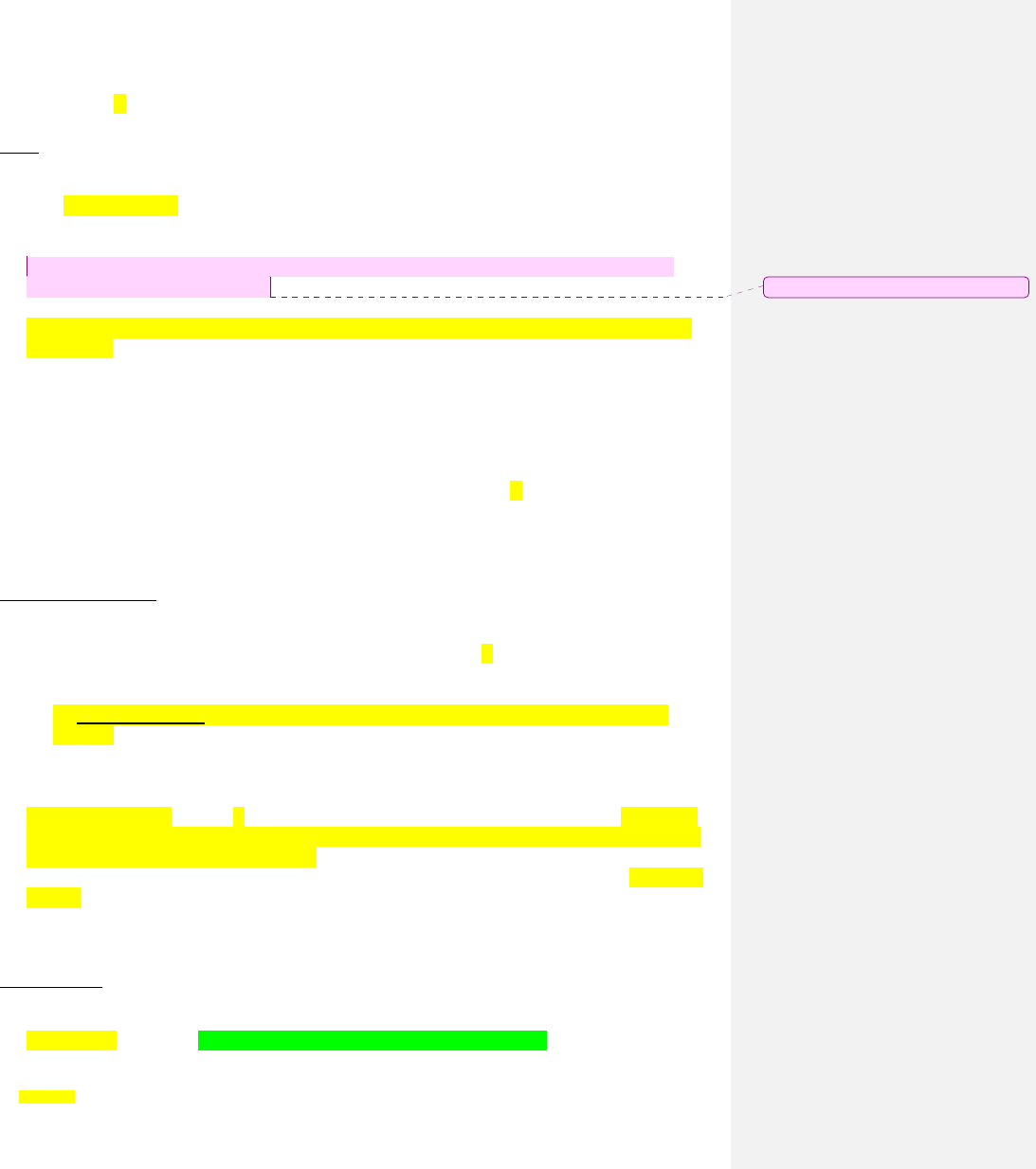
1
7
-
0XX
-
C1
2
Rev
10/14/16
Consultant shall be responsible for the complete performance of the tasks described in the “Scope of
Work,” Exhibit A, attached hereto and incorporated herein by this reference.
3. Term
a. The Term of this Agreement shall begin on the Effective Date of the Agreement and continue
until [insert end date], hereinafter referred to as the “Completion Date,” unless terminated earlier
as provided herein.
b. Services performed under this Agreement shall commence only upon issuance by SCAG to
Consultant of a Notice to Proceed.
[Delete the following clause if contract will complete on or before June 30, of the current
Fiscal Year]
c. Consultant services and reimbursements beyond June 30
th
of each Fiscal Year are subject to the
inclusion and funding agency approval of this project in the OWP for each Fiscal Year.
Therefore, on June 30
th
of each Fiscal Year, the Consultant must suspend all work under this
Agreement until an amendment allowing the work to continue has been fully executed by the
Parties. In the event this project is not approved in the OWP for each Fiscal Year this
Agreement shall terminate effective June 30
th
of the Fiscal Year funding was provided, as
specified in the “Contract Funding/Expenditure Summary,” Exhibit D, attached hereto and
incorporated herein by this reference.
d. Time is of the essence in the performance of services under this Agreement.
4. Schedule and Staffing
a. Consultant shall be responsible to SCAG for performing all services described in the Scope of
Work in a timely manner as set forth in the “Schedule,” Exhibit B, attached hereto and
incorporated herein by this reference.
[If Firm Fixed Price Contract, delete “Line Item Budget” and replace with “Price
Sheet.”]
b. Services described in the Scope of Work shall be performed by Consultant’s staff, subcontractors
or other members of the project team, hereinafter referred to as “Subconsultant(s),” listed in the
“Line Item Budget,” Exhibit C, attached hereto and incorporated by this reference. If there are
no Subconsultants identified in the Line Item Budget, any reference herein to “Subconsultants”
shall not be applicable in this Agreement. There shall be no change in the designation of
Consultant staff, Subconsultant(s), or any other information as identified in the Line Item
Budget without the prior written approval of the SCAG Chief Financial Officer. No
portion of the work included in this Agreement shall be subcontracted, except as provided herein,
without the prior, written authorization of the SCAG Chief Financial Officer.
5. Compensation
a. The maximum amount payable under this Agreement, including all expenses, shall not exceed
$XXX,XXX, subject to Sections 3 (Term) and 6 (Funding Requirements) of this Agreement.
Comment [N2]:
Cannot be removed.
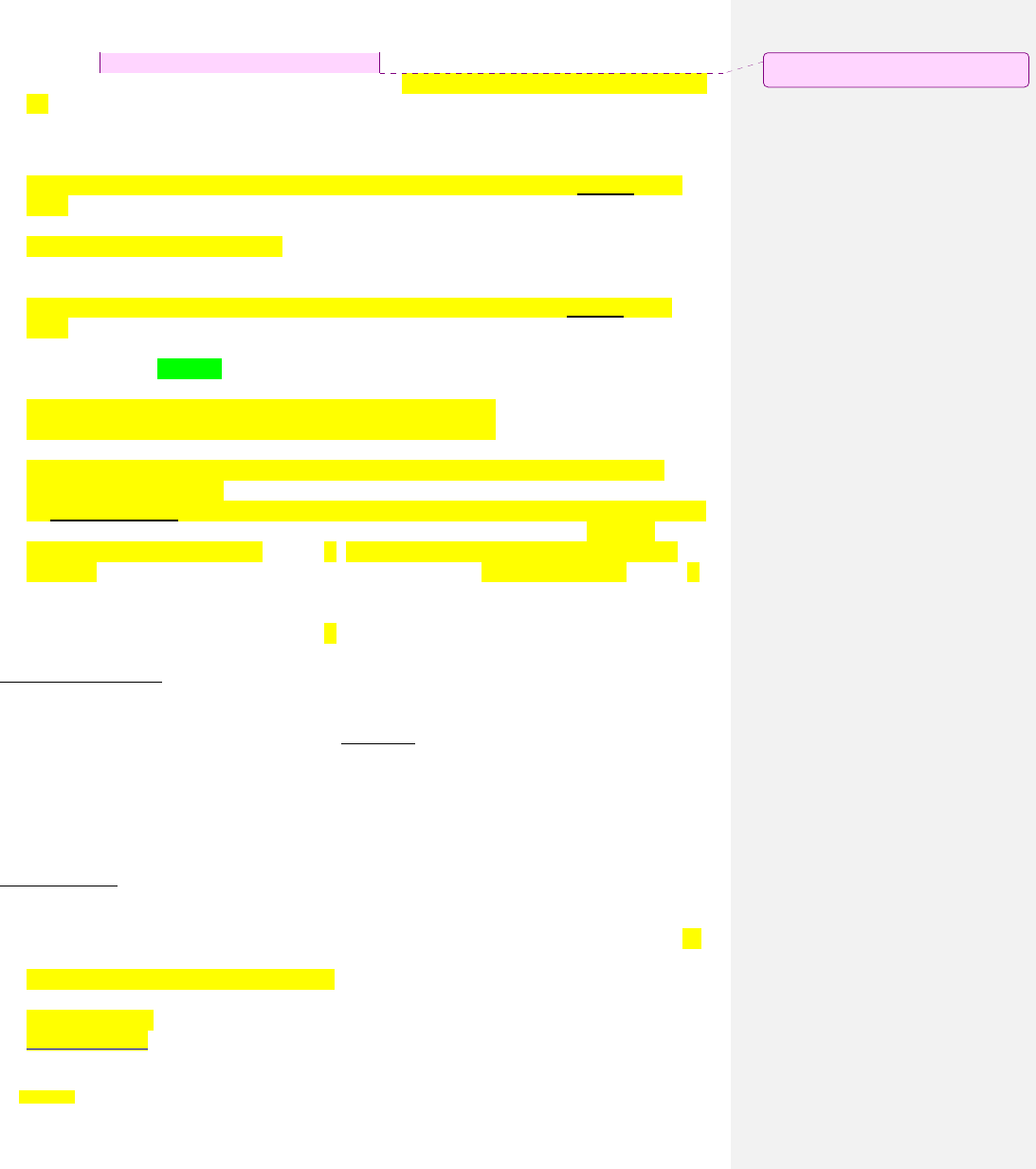
1
7
-
0XX
-
C1
3
Rev
10/14/16
b. This is an Actual Cost-Plus-Fixed Fee Agreement. Consultant shall be paid the applicable rate(s)
in effect at the time the expense is actually incurred [in accordance with the Price Sheet, Exhibit
C]. The Consultant shall provide the maximum rate for each position for the contract Term,
inclusive of any rate increase (e.g. merit or cost-of-living increase, etc.), however SCAG shall
only reimburse the Consultant the actual rate the Consultant pays its staff.
[Delete this section if contract will complete on or before June 30
th
of the current Fiscal
Year.]
c. This is a multi-fiscal year contract. Unexpended funds are not automatically carried over into the
next Fiscal Year.
[Delete this section if contract will complete on or before June 30 of the current Fiscal
Year.]
d. At this time it is anticipated that there shall be a budget for each applicable fiscal year as follows,
subject to Section 3c (Term):
The anticipated budget for Fiscal Year 2015-2016 is $XXX,XXX.
The anticipated budget for Fiscal Year 2016-2017 is $XXX,XXX.
[Delete “attached hereto and incorporated herein by this reference” if Exhibit D was
referenced in Section 3(c). ]
[If Firm Fixed Price Contract, delete “Line Item Budget” and replace with “Price Sheet.”]
e. For services rendered, Consultant shall receive funding in accordance with the “Contract
Funding/Expenditure Summary,” Exhibit D, attached hereto and incorporated herein by this
reference, and services shall be invoiced in accordance with the “Line Item Budget,” Exhibit C.
f. Invoices for payment shall refer to the Project Number(s) as specified in the “Contract
Funding/Expenditure Summary,” Exhibit D.
6. Funding Requirements
a. It is mutually understood between the Parties that this Agreement may have been written before
ascertaining the availability of funds for the total value of this Agreement, in order to avoid
program and fiscal delays that would occur if the Agreement were executed after that
determination was made.
b. SCAG reserves the option to terminate this Agreement or to amend this Agreement to reflect any
reduction in funds.
7. Project Manager
a. Consultant shall coordinate all work pursuant to this Agreement with SCAG through the Project
Manager. For purposes of this Agreement, SCAG designates the following Project Manager(s):
[Insert name of SCAG Project Manager]
SCAG Project Manager
(213) 236-XXXX
Comment [N3]:
This may change depending
on your contract type.
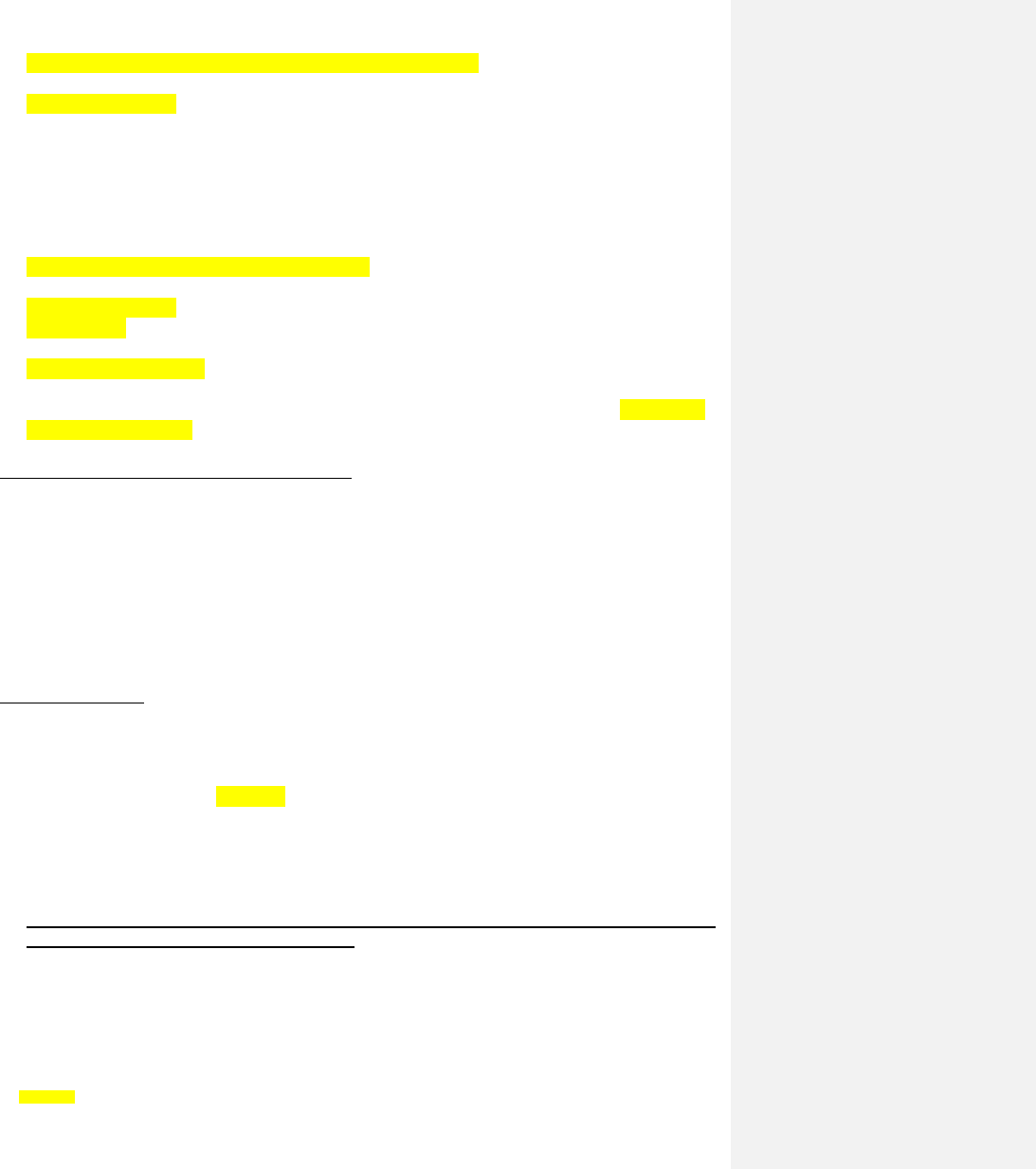
1
7
-
0XX
-
C1
4
Rev
10/14/16
[If applicable, insert name of Subregional Project Manager]
Subregional Project Manager
(XXX) XXX-XXXX
b. SCAG reserves the right to change the above designation upon written notice to Consultant. The
SCAG Project Manager shall review progress reports, approve invoices and determine whether
the Consultant’s performance under the Scope of Work has been satisfactorily completed.
c. The Consultant designates the following Consultant Project Manager:
[Insert name of Consultant Project Manager]
Consultant Project Manager
(XXX) XXX-XXXX
Email address
Insert any Key Personnel
d. The Consultant shall not change the designation of the Consultant Project Manager or other key
personnel stated above without the prior written approval of the SCAG Project Manager.
8. Assignment and Change in Ownership or Control
a. Consultant shall not assign any interest in this Agreement, and shall not transfer the same,
without written notification to and the prior written consent of SCAG in a form approved by the
SCAG Chief Financial Officer.
b. In the event of any change in ownership or control of Consultant’s firm or Subconsultant’s firm,
Consultant shall provide written notification to SCAG and SCAG shall determine the impact on
this Agreement, if any, of such change, and provide its response to Consultant within thirty (30)
days from the date notification is received by SCAG.
9. Agreement Changes
a. No alteration or deviation of the terms of this Agreement shall be valid unless made in writing in
the form of contract amendment and signed by the Parties. Consultant Project Manager or
SCAG Project Manager shall initiate a contract amendment via the “Contract Amendment
Request Form” (Request), Exhibit K, attached hereto and incorporated herein by this reference.
A Request only initiates the amendment process. SCAG must still approve the actual Contract
Amendment (Amendment). Such Amendment shall not become effective without the full
execution by the Parties and shall be effective as of the date of full execution by the Parties. If an
Amendment is to become effective before the date of full execution by the Parties, the effective
date of such Amendment shall be no earlier than the date that SCAG received the Request.
SCAG shall disallow any and all costs incurred by the Consultant prior to the effective date
of an Amendment resulting from a Request.
b. SCAG may request, at any time, amendments to this Agreement and will notify the Consultant
regarding such changes. Within ten (10) calendar days from the date of the written notice,
Consultant shall notify SCAG of the impact of such changes on the Scope of Work, Schedule
and Budget. Upon agreement between the Parties as to the required changes, an amendment to
this Agreement shall be prepared regarding the same.

1
7
-
0XX
-
C1
5
Rev
10/14/16
10. Invoicing for Payment
[If Firm Fixed Price Contract, delete “Line Item Budget,” and replace with “Price Sheet” if
you are using a detailed milestone schedule (i.e. Subtask 1.1, 1.2, etc.)]
For FFP
a. SCAG shall reimburse the Consultant as promptly as its fiscal procedures permit, upon receipt of
invoices submitted in accordance with this Agreement. Consultant agrees to be paid using
SCAG’s ACH Vendor Payment Authorization Form (available at:
scag.ca.gov/opportunities/Pages/BusinessWithSCAG.aspx. The Consultant shall complete the
ACH Form and email it to ACHpa[email protected], prior to executing the contract.
For CPFF
b. SCAG shall reimburse the Consultant as promptly as its fiscal procedures permit, using
Electronic Fund Transfer, ACH Vendor Payment Authorization Form (available at:
scag.ca.gov/opportunities/Pages/BusinessWithSCAG.aspx), upon receipt of itemized invoices
submitted in accordance with this Agreement. The Consultant shall complete the ACH Form
and email it to ACHpaymen[email protected], prior to executing the contract. Such
reimbursements shall be based upon actual eligible costs incurred by the Consultant consistent
with the Scope of Work, Schedule, and Line Item Budget.
c. In the event Consultant performs work after the Notice to Proceed but before the State Budget is
approved, Consultant agrees that SCAG shall have no obligation to make payment for such work
until after the State Budget is approved. No interest or other penalty shall be paid by SCAG.
d. Invoices for payment shall be submitted monthly if FFP add upon task completion. All Invoices
shall be accompanied by one (1) original of the written, narrative Progress Reports. The
Progress Reports shall describe the percentage and status of work completed, as identified in the
Scope of Work, technical papers, draft documentation, and any completed products. The
purpose of the Progress Reports is to allow SCAG to determine if the Consultant is completing
the activities identified in the Scope of Work, in accordance with the agreed upon Schedule, and
to provide opportunity to describe difficulties or special problems encountered so solutions can
be developed.
e. Invoices for payment shall be submitted by the last day of each month (“Invoice Due Date”).
Invoices not received by SCAG within thirty (30) calendar days of the Invoice Due Date may be
assessed a $1,000 penalty per invoice, which shall be deducted by SCAG in the payment of the
invoice.
Use the following clause if contract will end on or before June 30
th
of the current fiscal year
f. Invoices for payment for services rendered prior to June 30, 201? must be received by SCAG on
or before July 21, 201?. SCAG shall not be obligated for payment of invoices received after
such date. The format and content of all such invoices shall comply with Sections 11 (Invoicing
Format and Content) and 33 (Cost Principles) of this Agreement.
Use the following section if contract will continue beyond June 30
th
of the current fiscal
year.
g. Invoices for payment for services rendered prior to June 30
th
of each Fiscal Year, in which the
Comment [LM4]:
Cannot be removed.

1
7
-
0XX
-
C1
6
Rev
10/14/16
funding was provided, as specified in the “Contract Funding/Expenditure Summary,” Exhibit D,
must be received by SCAG on or before July 21 of each fiscal year. SCAG shall not be
obligated for payment of invoices received after such date. The format and content of all such
invoices shall comply with Sections 11 (Invoicing Format and Content) and 33 (Cost Principles)
of this Agreement.
h. Prompt Payment to Subconsultants: A Consultant or Subconsultant shall pay any sub-tier
consultant for satisfactorily completed work no later than ten (10) days of receipt of each
payment from SCAG. The ten (10) calendar days period is applicable unless a longer period is
agreed to in writing. Any delay or postponement of payment over thirty (30) calendar days may
take place only for good cause and with SCAG’s prior written approval. This requirement shall
not be construed to limit or impair any contractual, administrative, or judicial remedies otherwise
available to the Consultant or Subconsultant in the event of a dispute involving late payment or
nonpayment by the Consultant, deficient subconsultant performance, and/or noncompliance by a
subconsultant. This clause applies to both DBE and non-DBE subconsultants.
11. Invoicing Format and Content
a. All invoices submitted to SCAG for payment shall be e-mailed to
[email protected]a.gov
(file cannot exceed 10MB).
b. The invoice shall be entitled “Invoice” or otherwise clearly identify that the document is an
Invoice, and shall contain the following information:
(1) SCAG’s “Bill To” information as stated in the above paragraph “a.” of this section;
(2) Invoice number and/or billing number specified by Consultant. The invoice number must be
unique for each invoice submitted;
(3) Invoice date;
(4) Billing period specified with beginning and ending dates. The beginning date must not be
sooner than the Notice to Proceed date of the Agreement, or within any previous billing
dates;
(5) Total amount due for the billing period;
(6) Contract Number, Purchase Order Number, Project/Task Number, and Vendor Number (as
identified in Exhibit D or Notice to Proceed letter)
(7) Total Contract Value (as identified in Exhibit D); and
(8) SCAG Project Manager.
[If Firm Fixed Price Contract, add sentence below highlighted in blue and delete entire
section highlighted in yellow.]
c. All invoices shall specify the tasks/deliverables completed in accordance with the
tasks/deliverables set forth in the Scope of Work and Line Item Budget/Price Sheet, using the
format specified in Exhibit C2. All invoices shall be in the same format as the Line Item Budget,
Exhibit C. Specific budget category detail is given below:
(1) Direct Labor and Fringe Benefits: All direct labor charges shall include the class of
employee, rate per hour and number of hours. The Consultant shall provide the maximum rate
for each position for the contract Term, inclusive of any rate increase (e.g. merit or cost-of-
living increase, etc.), however SCAG shall only reimburse the Consultant the actual rate the
Consultant pays its staff.
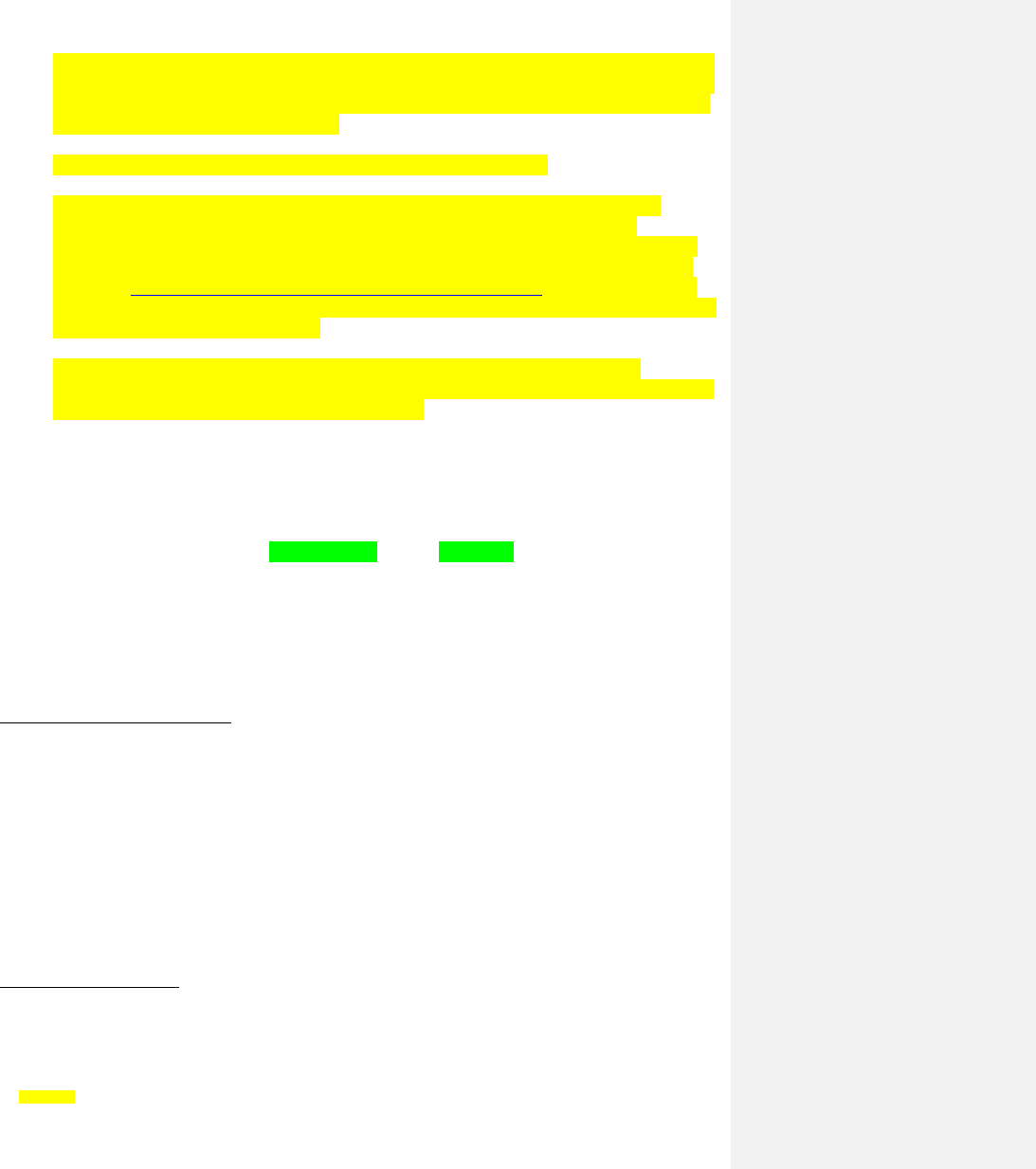
1
7
-
0XX
-
C1
7
Rev
10/14/16
(2) Consultant and any Subconsultant(s) charges: All Consultant invoices shall identify the name
and address of the Consultant and any Subconsultant(s), the percentage of work completed as
categorized in the Line Item Budget, the reimbursement rate, the total amount billed, and the
date and amount paid by the Consultant.
(3) Indirect Costs: The basis for billing and billing rate shall be specified.
(4) Direct Costs: All direct costs billed must be specifically identified and supported with
original receipts, invoices or statements. Any travel and subsistence costs must be
reasonable and are limited to those rates paid to non-represented/excluded State employees
under California’s State Department of Personnel Administration rules, subject to changes
posted at: http://www.dot.ca.gov/hq/asc/travel/ch12/1consultant.htm. SCAG does not pay
for the consultant’s travel time. Any direct costs not specifically identified in Exhibit C, Line
Item Budget, shall not be reimbursed.
(5) Fixed Fee: The amount of Fixed Fee billed should be equal to the proportion of the
Consultant work completed consistent with the Progress Report attached to each invoice, and
in accordance with the Line Item Budget, Exhibit C.
(6) Documentation: All costs charged to this Agreement by the Consultant shall be supported by
the following documentation: time record including full timesheets or time cards (must
account for the total activity for which each employee is compensated not just SCAG time),
payroll register, invoices and receipts evidencing in proper detail the nature of other charges,
and any other documentation requested by SCAG. These costs shall be costs reasonable,
allocable and allowable under Cost Principles cited in Section 33 of this Agreement.
d. Consultant shall invoice SCAG in United States currency and SCAG shall only reimburse
Consultant in United States currency. If Consultant provides receipts in any currency other
than United States currency to back up its invoices, Consultant must convert each receipt to
United States currency and document how the Consultant made the conversion or SCAG shall
not reimburse the Consultant for such invoices.
12. Agreement Completion Retainer
No retainage will be held by SCAG from progress payments due to Consultant. Consultant and
Subconsultant are prohibited from holding retainage from subconsultants. Any delay or
postponement of payment may take place only for good cause and with SCAG’s prior written
approval. Any violation of these provisions shall subject the violating Consultant or Subconsultant to
the penalties, sanctions, and other remedies specified in Section 7108.5 of the California Business
and Professions Code, if applicable. This requirement shall not be construed to limit or impair any
contractual, administrative, or judicial remedies, otherwise available to the Consultant or
Subconsultant in the event of a dispute involving late payment or nonpayment by the Consultant,
deficient Subconsultant performance, and/or noncompliance by a Subconsultant. This clause applies
to both DBE and non-DBE Subconsultants.
13. Satisfactory Performance
Payment for services under this Agreement is contingent upon SCAG’s determination that the
performance of the Consultant has been satisfactory, in accordance with the Scope of Work and
Section 42 (Standard of Care).
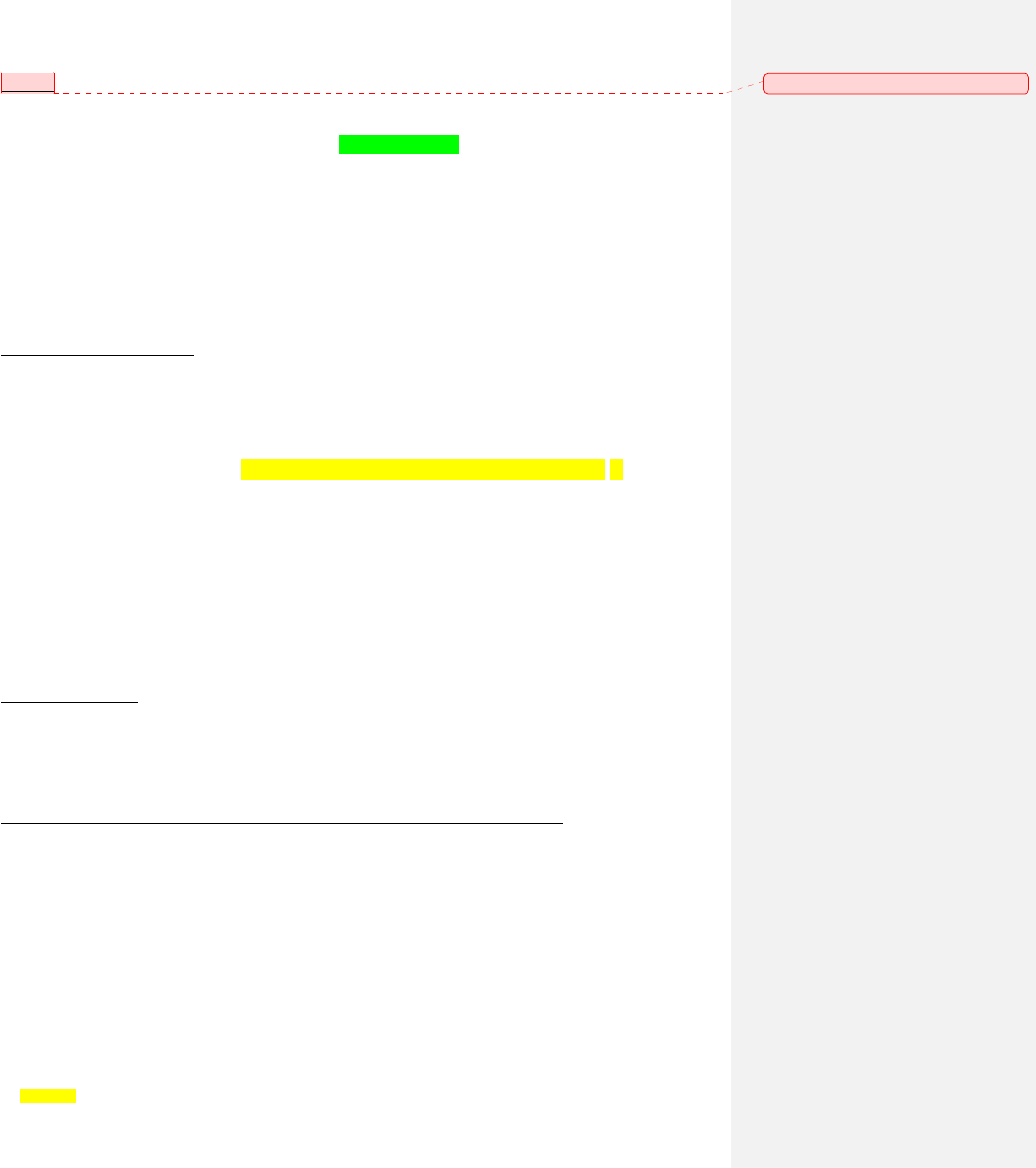
1
7
-
0XX
-
C1
8
Rev
10/14/16
14. Penalty
a. A ten percent (10%) penalty shall be imposed for each thirty (30) day calendar period beyond the
Agreement completion date, as specified in Section 3 (Term) of this Agreement, if the complete
product, as described in the Scope of Work, is not received and approved by SCAG by the
completion date. Such penalty shall be based on the total value of the Agreement, and shall not
be imposed if the delay is caused by SCAG.
b. Notwithstanding the above paragraph, the Consultant may request an extension in writing,
outlining the reasons for the delay and the new expected completion date. All such requests shall
be submitted to the SCAG Chief Financial Officer, and if approved, shall require a written
amendment to this Agreement fully executed by the Parties.
15. Quarterly Progress Reports
a. The Consultant shall submit a Quarterly Progress Report to the SCAG Project Manager no later
than five (5) days after the close of each quarter (i.e., for the first quarter, ending September 30,
the deadline is October 5), describing progress toward completion of all tasks, projects, and
products, conformance with project schedules, and reporting of all costs incurred for the Project
Number(s) as specified in the “Contract Funding/Expenditure Summary,” Exhibit D. In the
submittal of Quarterly Progress Reports, the Consultant shall include all completed products, in a
form determined by the SCAG Project Manager.
b. SCAG reserves the right to deem incomplete any Quarterly Progress Report that does not
sufficiently document the above-required information and may withhold payment of invoices
submitted pending the submission of required documentation by the Consultant.
c. The Consultant Project Manager shall meet with the SCAG Project Manager, as needed to
discuss work progress.
16. Inspection of Work
The Consultant and any Subconsultants shall permit SCAG and any designee of SCAG the
opportunity to review and inspect the project activities at all reasonable times during the
performance period of this Agreement including review and inspection on a daily basis.
17. Written and Electronic Versions of Work Products and Related Work Materials
a. For purposes of this Agreement, “Work Products” shall mean any deliverables, including reports,
studies, modeling output, newsletters or any other written or electronic materials provided
pursuant to the Scope of Work.
b. For purposes of this Agreement, “Related Work Materials” shall mean all materials obtained,
created by or provided to Consultant pursuant to this Agreement. Such materials shall include
but are not limited to ideas, notes, written documents, memoranda specifications, plans,
procedures, drawing descriptions, computer program data, input record data, databases, software,
and source codes. Related Work Materials shall include “Intellectual Property,” including but
not limited to copyrights, test data, trade secrets, and confidential information.
Comment [LM5]:
Cannot be removed.

1
7
-
0XX
-
C1
9
Rev
10/14/16
c. During or upon completion of the Scope of Work, Consultant shall deliver to the SCAG Project
Manager all Work Products and Related Work Materials. Such materials shall be provided in
electronic PDF format as follows:
(1) Five (5) electronic PDF copies on CD-ROM, or other medium pre-approved in writing by the
SCAG Project Manager;
(2) Two (2) electronic copies of all software (including source code, User’s Manual and full
documentation in printed and electronic form), databases, and web materials;
(3) Two (2) double-sided hard copies and two (2) electronic copies of all material prepared for
and used in presentations, including overhead, power point and hard copy presentations;
(4) Copies of all photographs taken at meetings, conferences, or project sites in conjunction with
the work performed pursuant to this Agreement. High-resolution tiff or jpeg files from
digital cameras are preferred. Files may be sent on ZIP disk or CD-ROM. Traditional
photographic prints are also acceptable; and,
(5) Other Related Work Materials, as requested by the SCAG Project Manager.
d. The electronic versions of all written materials and accompanying graphic images shall, when
printed or otherwise displayed, appear in the identical format, location, quality, and state of
replicating in which they appear in the hard copy versions. Similarly, any graphic images
accompanying the text of these written materials shall be included, in digitized form, in the
electronic version in the same places in which they appear in the hard copy version.
e. Consultant shall apply reasonable quality assurance procedures in the development of software,
and shall test all software prior to delivery to SCAG. Consultant shall provide to SCAG
documentation of quality assurance procedures applied, and a complete record of the software
testing performed.
Delete all of clause “f” if the project is 100% TDA or local funded.
f. The title pages of all written Work Products produced under this Agreement shall include the
following:
“Funding: The preparation of this report was financed in part through grants from the United
States Department of Transportation (DOT).” [If Applicable]
PROJECTS THAT ARE STATE-OTHER OR SP&R FUNDED USE:
“Additional financial assistance was provided by the California State Department of
Transportation.” or
FOR PROJECTS WITH FEDERAL FUNDING USE:
"The preparation of this report has been financed in part through grant[s] from the Federal
Highway Administration and Federal Transit Administration, U.S. Department of
Transportation. The contents of this report do not necessarily reflect the official views or policy
of the U.S. Department of Transportation."
For Sustainability projects ONLY- if project is 100% TDA funded, delete yellow highlighted
text and replace with “State Transportation Development Act (TDA)” below from clause “g”.
g. (f) All written Work Products produced under this Agreement shall contain the following
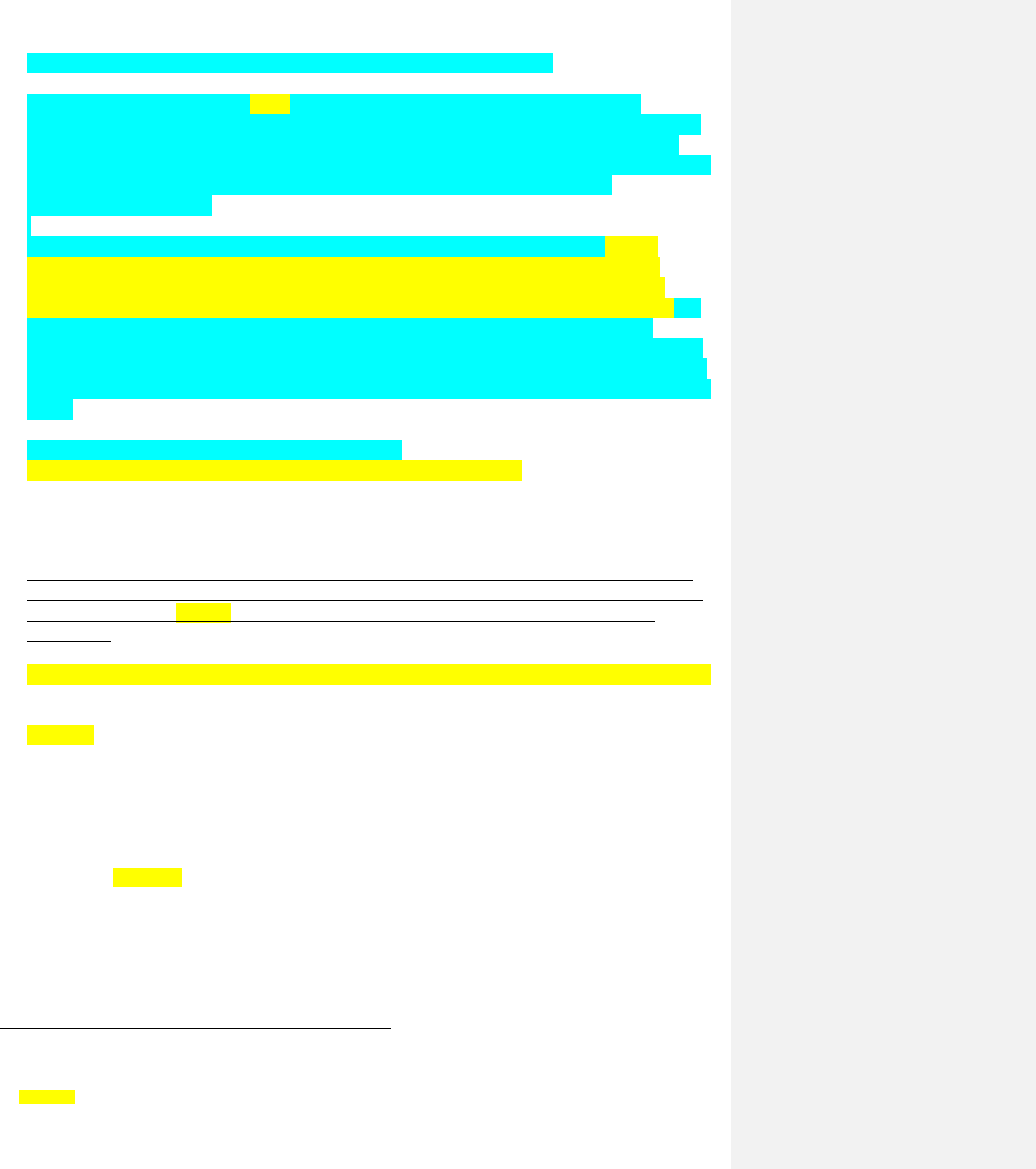
1
7
-
0XX
-
C1
10
Rev
10/14/16
disclaimer in a separate section preceding the main body of the document:
This is a project for the City of TBD with funding provided by the Southern California
Association of Governments’ (SCAG) Sustainability Program. SCAG’s Sustainability Program
assists Southern California cities and other organizations in evaluating planning options and
stimulating development consistent with the region’s goals. Sustainability Program tools support
visioning efforts, infill analyses, economic and policy analyses, and marketing and
communication programs.
The preparation of this report has been financed in part through grant(s) from the Federal
Highway Administration (FHWA) and the Federal Transit Administration (FTA) through
the U.S. Department of Transportation (DOT) in accordance with the provisions under the
Metropolitan Planning Program as set forth in Section 104(f) of Title 23 of the U.S. Code. The
contents of this report reflect the views of the author who is responsible for the facts and
accuracy of the data presented herein. The contents do not necessarily reflect the official views
or policies of SCAG, DOT or the State of California. This report does not constitute a standard,
specification or regulation. SCAG shall not be responsible for the City's use or adaptation of the
report.
Delete clause “h” if this is a Sustainability Project
Delete “or DOT” from clause “h” if project is 100% TDA funded.
h. All written Work Products produced under this Agreement shall further contain the following
disclaimer in a separate section preceding the main body of the document:
“The contents of this report reflect the views of the author who is responsible for the facts and
accuracy of the data presented herein. The contents do not necessarily reflect the official views
or policies of SCAG or DOT. This report does not constitute a standard, specification or
regulation.”
[Insert the following four clauses as determined applicable by the SCAG Project Manager].
i. Geographic Information System (GIS), spatial data, and databases provided to SCAG pursuant to
this Agreement shall be accompanied by metadata conforming to the requirements specified in
Exhibit E, “Spatial Data/Metadata Requirements,” attached hereto and incorporated herein by
this reference.
j. Graphics products must conform to the requirements specified in Exhibit F, “Graphics
Requirements for Consultants”, attached hereto and incorporated herein by this reference.
k. Web material prepared or acquired under this Agreement shall conform to the requirements
specified in Exhibit G, “Web Policies and Guidelines for Consultants”, attached hereto and
incorporated herein by this reference.
l. Mapping prepared or acquired under this Agreement shall conform to the requirements specified
in Exhibit H, “Mapping Guidelines for Consultants”, attached hereto and incorporated herein by
this reference.
18. Ownership, Confidentiality, and Use of Work Products
a. All Work Products and Related Work Materials including Intellectual Property, as defined in

1
7
-
0XX
-
C1
11
Rev
10/14/16
Section 17, Subsections a and b (Written and Electronic Versions of Work Products and Related
Work Materials), respectively, of this Agreement, shall become the property of SCAG, and all
publication rights are reserved to SCAG. The Consultant shall not copyright Work Products or
Related Work Materials.
b. Related Work Materials including Intellectual Property obtained by Consultant pursuant to a
third party agreement and related to the services provided by Consultant pursuant to this
Agreement, shall become the property of SCAG.
c. Consultant shall cooperate in the execution of all documents necessary to protect SCAG’s rights
to such materials. Consultant shall notify SCAG in writing of all Intellectual Property developed
or conceived in the course of its performance under this Agreement.
d. Consultant shall assign and does hereby assign to SCAG all rights, title and interest to
Intellectual Property conceived or developed by Consultant in the course of Consultant work
pursuant to this Agreement. Consultant shall cooperate in the execution of all documents
necessary to protect SCAG’s rights to the Intellectual Property.
e. Subject to the California Public Records Act, all Work Products and Related Work Materials
including Intellectual Property shall be held confidential by Consultant. Nothing furnished to
Consultant, which is otherwise known to Consultant or is generally known, or has become
known, to the related industry shall be deemed confidential.
f. The Consultant shall not use, release, reproduce, distribute, publish, adapt for future use or
otherwise use Work Products and Related Work Materials for purposes other than the
performance of the Scope of Work, nor authorize others to do so, without prior written
permission of SCAG Legal Counsel; nor shall such materials be disclosed to any person or entity
not connected with the performance of the work. Consultant shall also safeguard such
confidential materials from unauthorized disclosure, using the same standard of care to avoid
disclosure, as the Consultant treats its confidential information, but in no case less than
reasonable care.
g. Upon termination of this Agreement or when requested to do so by SCAG, Consultant shall erase
all copies of Work Products and Related Work Materials from its computers.
h. All equipment, including, but not limited to, computer hardware, printing and duplication
equipment, multimedia equipment, software tools and programs, and upgrade packages to
existing equipment, procured in whole or part by funds provided under this Agreement, are the
property of SCAG. SCAG shall determine the disposition of all such property upon completion
or termination of this Agreement.
i. SCAG may utilize any Work Products or Related Work Materials provided by Consultant
pursuant to this Agreement, in any manner which SCAG deems appropriate without additional
compensation to Consultant.
19. Termination
[Delete clause (a.) if contract will complete on or before June 30, of the current Fiscal Year –
Renumber the clauses as necessary]
a. Termination Resulting from Lack of Approval in the OWP

1
7
-
0XX
-
C1
12
Rev
10/14/16
In the event that the work provided for under this Agreement is not approved in the next OWP,
the subsequent OWP, or OWP Amendments, this Agreement, as provided in Section 3 (Term), is
deemed to be terminated effective June 30th of the applicable Fiscal Year.
b. Termination for Convenience of SCAG
SCAG may terminate this Agreement at any time by giving notice to the Consultant of such
termination (including the effective termination date) at least thirty (30) calendar days before the
effective date of such termination.
In such event, all finished or unfinished documents and other materials as described in this
Agreement, at the option of SCAG, become SCAG’s property. If this Agreement is terminated
by SCAG, as provided herein, SCAG’s only obligation shall be the payment of fees and
expenses incurred prior to the termination date, in accordance with the cost provisions of this
Agreement.
c. Termination for Cause
If through any cause, the Consultant shall fail to fulfill in a timely and proper manner its
obligations under this Agreement, or if the Consultant violates any of the covenants, terms, or
stipulations of this Agreement, SCAG shall thereupon have the right to terminate the Agreement
by giving not less than ten (10) working days written notice to the Consultant of the intent to
terminate and specifying the effective date thereof. In such event, all finished or unfinished
documents, data, studies, surveys, drawings, maps, models, photographs, reports or other
materials prepared by the Consultant under this Agreement shall, at the option of SCAG, become
SCAG’s property.
20. Compliance with Laws, Rules, and Regulations
Consultant shall perform all services under this Agreement in accordance and in full compliance
with all applicable Federal, State and local statutes, rules, regulations, and policies and procedures
and shall secure and maintain all licenses or permits required by law.
21. Independent Contractor
The Consultant agrees to provide the services set forth in this Agreement in the capacity of an
independent contractor and neither the Consultant nor any of its employees or agents shall be
considered to be an employee or agent of SCAG.
22. Conflict of Interest
a. Consultant and any of its sub-consultants (regardless of the sub-tier) agrees to abide by the
SCAG Conflict of Interest Policy as it applies to “consultants,” as defined under the SCAG
Conflict of Interest Policy, posted at: http://scag.ca.gov/business/downloads/COI_policy.pdf.
b. Consultant further agrees that during the term of this Agreement, it shall not accept employment
from any other person, firm or corporation where such is a conflict of interest or where it is
likely to lead to a conflict of interest between SCAG’s interest and the interest of such person,
firm or corporation or any other third party.

1
7
-
0XX
-
C1
13
Rev
10/14/16
23. Contingency Fees or other Unlawful Consideration
a. The Consultant warrants, by execution of this Agreement, that no person or selling agency has
been employed or retained to solicit or secure this Agreement upon an agreement or
understanding for a commission, percentage, brokerage, or contingency fee, excepting bona fide
employees or bona fide established commercial or selling agencies maintained by the Consultant
for the purpose of securing business. For breach or violation of this warranty, SCAG has the
right in its sole discretion to terminate this Agreement with its only obligation to pay for the
value of the work actually performed, or to deduct from the Agreement price, or otherwise
recover, the full amount of such commission, percentage, brokerage, or contingency fee.
b. The Consultant further warrants that this Agreement was not obtained or secured through
rebates, kickbacks or other unlawful consideration either promised or paid to any SCAG
employee. For breach or violation of this warranty, SCAG shall have the right, in its discretion,
to terminate the Agreement without liability, to pay only for the value of work performed, or to
deduct from the Agreement price or otherwise recover the full amount of each rebate, kickback
or other unlawful consideration.
24. Release of Information
Consultant shall not release any information to a third party or otherwise publish or utilize any
information obtained or produced by it as a result of or in connection with the performance of
services under this Agreement without the prior written authorization of the Chief Financial Officer.
25. Disputes
Except as otherwise provided in this Agreement, any dispute arising under this Agreement which is
not disposed of by mutual agreement shall be decided through binding arbitration by a three (3)
member panel in accordance with the rules of the American Arbitration Association.
26. Indemnity
Use the following indemnification provisions for contracts that do not involve A&E, design or
construction related type of contracts (such as one with an architect, design engineer, etc.)
a. Consultant assumes all risk of injury to its employees, agents and contractors, including loss or
damage to property.
b. When the law establishes a professional standard of care for Consultant’s services, to the fullest
extent permitted by law, Consultant shall indemnify, protect, defend and hold harmless SCAG,
its members, officers, Regional Council Board members, employees and agents from and against
any and all losses, liabilities, damages, costs and expenses, including attorney’s fees and costs to
the extent caused in whole or in part by any intentional, negligent or wrongful act, error or
omission of Consultant, its agents, employees, or subconsultants arising out of the performance
of professional services under this Agreement.
c. For all other services performed by Consultant pursuant to this Agreement, the Consultant shall
indemnify, protect, defend and hold harmless SCAG, its members, officers, Regional Council
members, employees and agents from and against any and all losses, liabilities, damages, costs
and expenses, including attorney’s fees and costs where the same arises out of, are a
Comment [LM6]:
Cannot be removed.

1
7
-
0XX
-
C1
14
Rev
10/14/16
consequence of, or are in any way attributable to, in whole or in part, the performance of this
Agreement by the Consultant, its agents, employees or subconsultants.
d. Consultant shall defend, indemnify, and hold harmless SCAG, its members, officers, Regional
Council Board Members, employees and agents against any and all claims against SCAG based
upon allegations that Consultant has wrongfully utilized Intellectual Property of others in
performing work pursuant to this Agreement or that SCAG has wrongfully used Intellectual
Property developed by Consultant pursuant to this Agreement.
Use the following indemnification provisions for contracts that involve A&E, design or
construction (such as one with an architect, design engineer, etc.)
a. Consultant assumes all risk of injury to its employees, agents and contractors, including loss or
damage to property.
b. Consultant shall indemnify and hold harmless SCAG, its members, officers, Regional Council
Board members, employees and agents from an against all claims, suits or causes of action for
injury to any person or damage to any property to the extent caused by its willful misconduct,
recklessness and negligent acts arising out of its performance of work under this Agreement.
Consultant will reimburse SCAG for any defense costs incurred to the extent attributable to
Consultant’s willful misconduct, recklessness and negligent acts.
c. For all other services performed by Consultant pursuant to this Agreement, the Consultant shall
indemnify, protect, defend and hold harmless SCAG, its members, officers, Regional Council
members, employees and agents from and against any and all losses, liabilities, damages, costs
and expenses, including attorney’s fees and costs where the same arises out of, are a
consequence of, or are in any way attributable to, in whole or in part, the performance of this
Agreement by the Consultant, its agents, employees or subconsultants.
27. Non-Discrimination/Equal Employment Opportunity
a. Consultant shall not, during the performance of this Agreement or in selection or retention of
Subconsultants, including procurement of materials and leases of equipment, unlawfully
discriminate, harass or allow harassment against any employee or applicant for employment
because of sex, race, color, ancestry, religion creed, national origin, physical disability (including
HIV and AIDS), medical condition (cancer), age, marital status, denial of family and medical
care leave, or denial of pregnancy disability leave.
Consultant shall ensure, and shall require that its Subconsultant(s) ensure that the evaluation and
treatment of their employees and applicants for employment are free from such discrimination
and harassment.
Consultant shall comply and ensure that its Subconsultant(s) comply with the provisions of the
Fair Employment and Housing Act (Government Code, Section 12900 et seq.) and the applicable
regulations promulgated thereunder (California Code of Regulations, Title 2, Section 7285.0 et
seq.). The applicable regulations of the Fair Employment and Housing Commission
implementing Government Code, Section 12990 (a-f), set forth in Chapter 5 of Division 4 of
Title 2 of the California Code of Regulations, are incorporated into this Agreement by reference
and made a part hereof as if set forth in full.
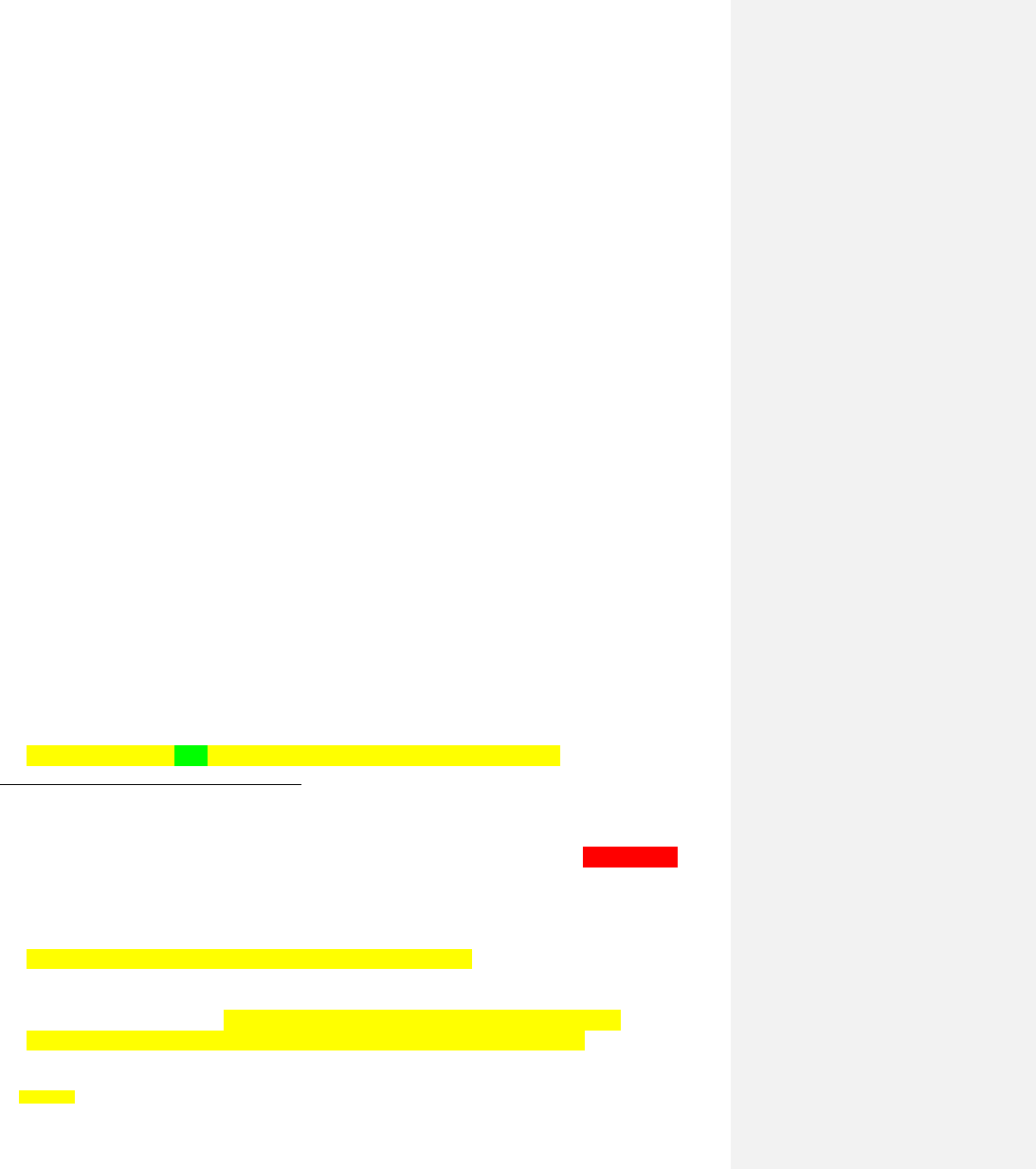
1
7
-
0XX
-
C1
15
Rev
10/14/16
Consultant and its Subconsultant(s) shall give written notice of its obligations under this clause
to labor organizations with which they have collective bargaining or other labor agreements.
b. The Consultant and its Subconsultant(s) shall comply with Title VI of the Civil Rights Act of
1964, as amended, and with the regulations relative to Title VI, (nondiscrimination in federally-
assisted programs of the United States Department of Transportation (DOT), 49 C.F.R Part 21
and 23 C.F.R. Part 200; hereinafter referred to as “DOT regulations,”) and 49 C.F.R Part 26,
which are herein incorporated by reference and made a part of this Agreement. Wherever the
term “Contractor” appears therein, it shall mean Consultant.
c. Consultant shall permit and shall require its Subconsultant(s) to permit access to all records of
employment, employment advertisements, application forms, and other pertinent data and
records by the State Fair Employment Practices and Housing Commission or any other agency of
the State of California designated by the State to investigate compliance with this Section.
d. Solicitations for Subconsultant(s), Including Procurement of Materials and Equipment: In all
solicitations either by competitive bidding or negotiations made by the Consultant for work to be
performed under a subcontract, including procurement of materials or leases of equipment, each
potential Subconsultant or supplier shall be notified by the Consultant of the Consultant’s
obligations under this Agreement and the DOT regulations relative to nondiscrimination.
e. Sanctions for Noncompliance: Failure by the Consultant to carry out the requirements above is a
material breach of this Agreement, which may result in sanctions as SCAG may determine to be
appropriate, including, but not limited to:
(1) Withholding of payments to the Consultant under this Agreement until the Consultant
complies, and/or
(2) Cancellation, termination or suspension of the Agreement, in whole or in part.
f. Incorporation of Provisions: Any subcontract entered into as a result of this Agreement shall
contain all of the provisions of “a” through “e” of this section. The Consultant shall take such
action with respect to any subcontract or procurement as SCAG may direct as a means of
enforcing such provisions including sanctions for noncompliance.
Remove this clause and Exhibit I if the project is100% General funded
28. Disadvantaged Business Enterprise (DBE)
a. The Consultant and its Subconsultant(s) shall not discriminate on the basis of race, color,
national origin, or sex in the performance of this contract. The Consultant shall carry out
applicable requirements of 49 CFR Part 26 in the award and administration of State or DOT-
assisted contracts or in the administration of SCAG’s DBE Program. Failure by the Consultant
to carry out these requirements is a material breach of this contract, which may result in the
termination of this contract or such other remedy, as SCAG deems appropriate.
[Delete highlighted paragraph if there is no Subconsultants]
b. It is the policy of SCAG, Caltrans, and DOT, that the Disadvantaged Business Enterprises
(DBEs), as defined in 49 CFR Part 26, shall have an equal opportunity to receive and participate
in DOT-assisted contracts. Consultant and its Subconsultants shall comply with the
requirements of 49 CFR Part 26 and with SCAG’s DBE Program, as amended.
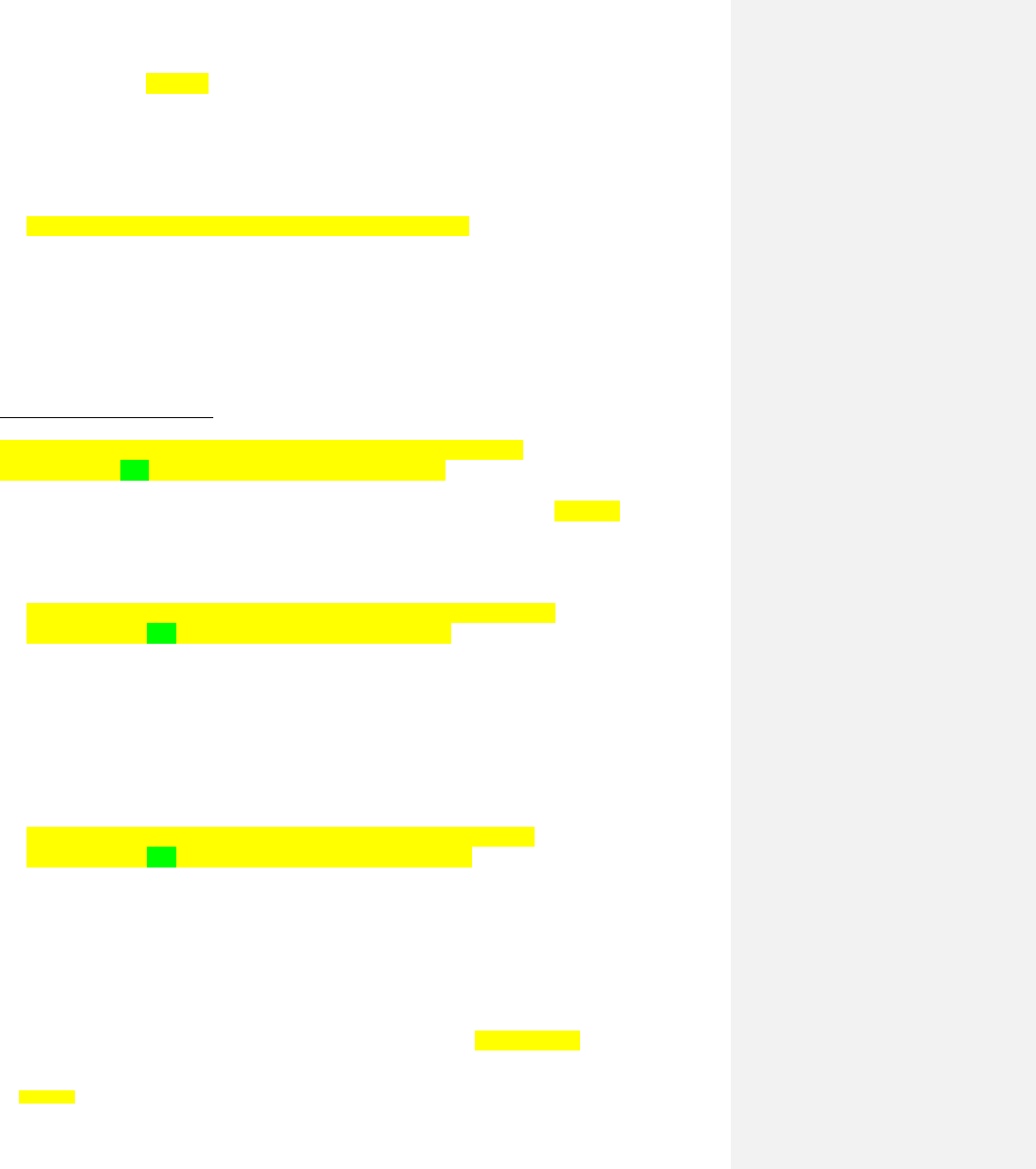
1
7
-
0XX
-
C1
16
Rev
10/14/16
c. A “Consultant Contract DBE Commitment” form is attached hereto and incorporated herein by
this reference as Exhibit I. Even if no DBE participation will be reported, the Consultant shall
complete and sign such form at the time this Agreement is executed. Upon completion of the
contract, regardless of whether the Consultant obtained DBE participation, the Consultant shall
prepare a summary of the DBE records, certified correct, and submit this on the “Final Report-
Utilization of DBE, First-Tier Subcontractors” form (Exhibit J). This form shows the total
dollars paid to each sub consultant, whether DBE or non-DBE.
[Delete this entire paragraph if there is no Subconsultants]
d. During the period of this Agreement, the Consultant shall maintain records of all applicable
subcontracts advertised and entered into germane to this Agreement, documenting the actual
DBE participation and records of materials purchased from DBE suppliers. Such documentation
shall show the name and business address of each DBE Subconsultant or vendor, and the total
dollar amount actually paid each DBE Subconsultant or vendor. Upon completion of the
Agreement, regardless of whether DBE participation is obtained, a summary of the DBE records
shall be prepared, certified correct, and submitted on a form that shall be provided by SCAG.
29. Records Retention and Audits
Is the project 100% TDA funded? If yes, then delete following clause.
If the project is not 100% TDA funded keep/use the clause.
a. The Consultant and its Subconsultant(s) shall maintain all source documents, books, and records
connected with their performance of this Agreement for a minimum of three (3) years from the date
that SCAG makes final payment to the Consultant or until audit resolution is achieved for each
annual OWP Agreement (between SCAG and Caltrans), whichever is later, and all other related,
pending matters are closed.
Is the project 100% TDA funded? If yes keep/use the following clause.
If the project is not 100% TDA funded delete the clause.
b. The Consultant and its Subconsultant(s) shall maintain all source documents, books, and records
connected with their performance of this Agreement for a minimum of four (4) years following the
close of SCAG’s Fiscal Year.
c. Consultant shall establish and maintain, an accounting system conforming to Generally Accepted
Accounting Principles (GAAP) to support invoices which segregate and accumulate the costs of the
applicable Project Number(s) by line item and produce Quarterly Reports which clearly identify
reimbursable costs and other expenditures related to such Project Number(s).
Is the project 100% TDA funded? If yes delete the following clause.
If the project is not 100% TDA funded keep/use the clause.
d. Upon request, at any time during normal business hours and as often as SCAG, State of California
Department of Transportation (Caltrans), Bureau of State Audits, or other State and Federal
agencies or any duly authorized representative may deem necessary, the Consultant shall make
available for examination all of its records with respect to all matters covered by this Agreement for
purposes of audit, examination, or to make copies or transcripts of such records, including, but not
limited to, contracts, invoices, payrolls (including time sheets or timecards), personnel records,
conditions of employment and other records relating to all matters covered by this Agreement.
Such records and access to the facilities and premises of the Consultant shall be made available
during the period of performance of this Agreement, and for three (3) years from the date that
SCAG makes final payment to the Consultant or until audit resolution is achieved for each annual

1
7
-
0XX
-
C1
17
Rev
10/14/16
OWP Agreement (between SCAG and Caltrans), whichever is later, and all other related, pending
matters are closed.
Is the project 100% TDA funded? If yes keep/use the following clause.
If the project is not 100% TDA funded delete the clause.
e. Upon request, at any time during normal business hours and as often as SCAG, The State
Controller, County Auditors (in SCAG region), or other government agencies or any duly
authorized representative may deem necessary, the Consultant shall make available for examination
all of its records with respect to all matters covered by this Agreement for purposes of audit,
examination, or to make copies or transcripts of such records, including, but not limited to,
contracts, invoices, payrolls, personnel records, conditions of employment and other records relating
to all matters covered by this Agreement. Such records and access to the facilities and premises of
the Consultant shall be made available during the period of performance of this Agreement, and for
a minimum of four (4) years following the close of SCAG’s Fiscal Year.
f. The Consultant agrees and shall require that all of its agreements with Subconsultant(s) contain
provisions requiring adherence to this section in its entirety.
30. Federal and State Lobbying Activities Certification
a. By signing this Agreement, the Consultant certifies, to the best of its knowledge and belief, that
no State or Federal funds have been paid or will be paid, by or on behalf of SCAG, to any person
for influencing or attempting to influence an officer or employee of any State or Federal agency,
a Member of the State Legislature or United States Congress, an officer or employee of the
Legislature or Congress, or any employee of a Member of the Legislature or Congress in
connection with the awarding of any State or Federal contract, the making of any State or
Federal grant, the making of any Federal loan, the entering into of any cooperative agreement, or
the extension, continuation, renewal, amendment, or modification of any State or Federal
contract, grant, loan, or cooperative agreement.
b. If any funds other than State or Federal funds have been paid or will be paid to any person for
influencing or attempting to influence an officer or employee of any Federal agency, a Member
of Congress, an officer or employee of Congress, or an employee of a Member of Congress in
connection with this Federal contract, grant, loan, or cooperative agreement, the Consultant shall
complete and submit Federal Standard Form-LLL, “Disclosure Form to Report Lobbying,” in
accordance with those form instructions.
c. This certification is a material representation of fact, upon which reliance was placed when this
Agreement was entered into. Submission of this certification is a prerequisite for making or
entering into this Agreement pursuant to 31 U.S.C. 1352.
[Delete if contract is under $100,000]
d. The Consultant also agrees by signing this Agreement that it will require that the language of this
certification be included in all subcontracts funded wholly or in part by any funds provided
herein and which exceed $100,000 and that all such Subconsultants shall certify and disclose
accordingly.
31. Certifications and Assurances
a. Consultant shall adhere to the requirements contained in SCAG’s annual Certification and

1
7
-
0XX
-
C1
18
Rev
10/14/16
Assurances (FHWA and FTA “Metropolitan Transportation Planning Process Certification”)
submitted as part of SCAG’s OWP, pursuant to 23 CFR 450.334 and 23 U.S.C. 134. This
Certification shall be published annually in SCAG’s OWP. Such requirements shall apply to
Consultant to the same extent as SCAG and may include, but are not limited to:
(1) Title VI of the Civil Rights Act of 1964 and Title VI Assurance executed by California under
23 U.S.C. 324 and 29 U.S.C. 794;
(2) Pub. Law 105-178, 112 Stat. 107 and any successor thereto, regarding the involvement of
disadvantaged business enterprises in FHWA and FTA funded projects (Sec. 105(f), Pub. L.
970424, 96 Stat. 2100, 49 CFR part 26); and
(3) The Americans with Disabilities Act of 1990 (Pub. L. 101-336, 104 Stat. 327, as amended)
and the United States Department of Transportation (US DOT) implementing regulations (49
CFR 27, 37, and 38).
b. Consultant shall additionally comply with the requirements contained in the annual FTA
“Certifications and Assurances for FTA Assistance,” including “Certifications and Assurances
Required of Each Applicant” and the “Lobbying Certification” in compliance with 49 U.S.C.
Chapter 53; published annually in SCAG’s OWP. Such assurances shall apply to Consultant to
the same extent as SCAG, and include but are not limited to the following areas:
(1) Standard Assurances
(2) Debarment, Suspension, and Other Responsibility Matters for Primary Covered Transactions
(3) Drug Free Work Place Agreement
(4) Intergovernmental Review Assurance
(5) Nondiscrimination Assurance
(6) DBE Assurance
(7) Nondiscrimination on the Basis of Disability
(8) Certification and Assurances required by the U.S. Office of Management and Budget
c. The Consultant shall require its Subconsultant(s) to comply with these Certifications, and agrees
to furnish documentation at no cost to SCAG to support this requirement that all of its
agreements with Subconsultant(s) contain provisions requiring adherence to this section in its
entirety.
32. Contract Award
In accordance with “Uniform Administrative Requirements, Cost Principles, and Audit
Requirements for Federal Awards,” 2 CFR Part 200, et seq., and successors thereto and applicable
state law and procedures, all Subconsultant contracts containing funds provided under this
Agreement are required to be competitively procured and awarded consistent with Local Program
Procedures 00-05 (Pre-award Audit Requirements and Consultant Procurement) or successors
thereto.
33. Cost Principles
a. Consultant agrees to comply with the following:
(1) the Contract Cost Principles and Procedures, 48 Code of Federal Regulations, Federal
Acquisition Regulations System, Chapter 1, Part 31, et seq., 2 CFR Part 225 (Office of
Management and Budget Circular A-87), “Cost Principles for State, Local, and Indian Tribal
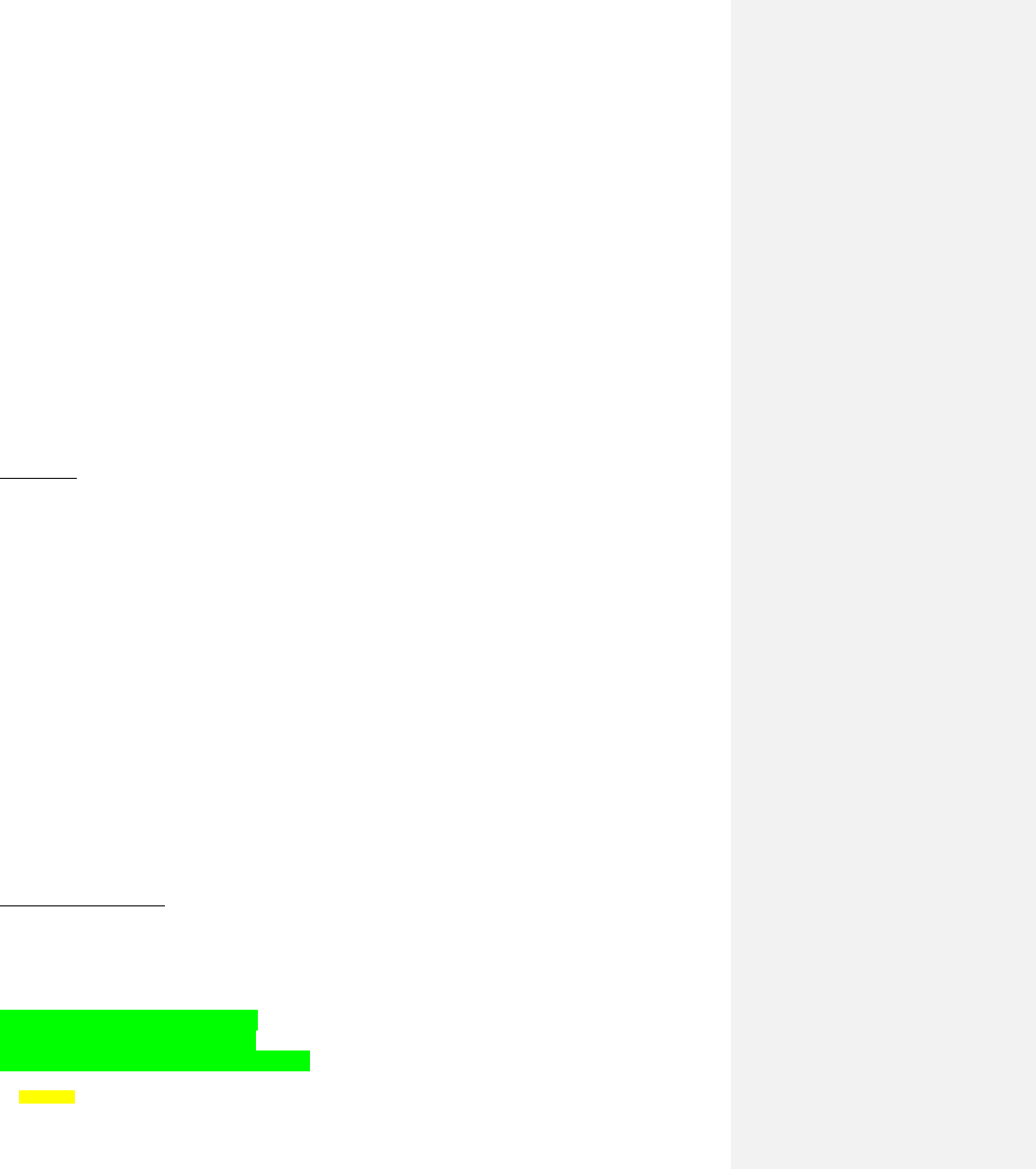
1
7
-
0XX
-
C1
19
Rev
10/14/16
Governments,” and successors thereto, shall be used to determine the allowability of
individual project cost items, and
(2) the Federal administrative procedures in accordance with “Uniform Administrative
Requirements, Cost Principles, and Audit Requirements for Federal Awards,” 2 CFR Part
200, et seq., and successors thereto.
b. Any costs for which Consultant receives payment or credit that is determined by a subsequent
audit or other review by either SCAG, Caltrans or other State or Federal authorities to be
unallowable under, but not limited to, 2 CFR Part 225 (OMB Circular A-87); 48 CFR, Chapter 1,
Part 31; or 2 CFR Part 200, et seq., and successors thereto, are to be repaid by Consultant within
thirty (30) days of Consultant receiving notice of audit findings. Should Consultant fail to
reimburse moneys due SCAG within thirty (30) days of demand, or within such other period as
may be agreed between Parties hereto, SCAG is authorized to withhold future payments due
Consultant.
c. Consultant agrees to furnish documentation to SCAG to support this requirement that all of its
agreements with Subconsultants contain provisions requiring adherence to this section in its
entirety.
34. Stop Work
a. SCAG may, at any time, by written Stop Work Order to the Consultant, require the Consultant to
stop all, or any part, of the work called for by this Agreement for a period up to ninety (90) days
after the Stop Work Order is delivered to the Consultant, and for any further period to which
SCAG authorizes. The Stop Work Order shall be specifically identified as such and shall
indicate it is issued under this clause. Upon receipt of the Stop Work Order, the Consultant shall
immediately comply with its terms and take all reasonable steps to minimize the incurrence of
costs allocable to the work covered by the Stop Work Order during the period of work stoppage.
Within ninety (90) days after a Stop Work Order is delivered to the Consultant, or within any
extension of that period by SCAG, SCAG shall either:
(1) Cancel the Stop Work Order; or
(2) Terminate the work covered by the Stop Work Order as provided for in the termination for
convenience clause of this Agreement.
b. If a Stop Work Order is issued under this section, SCAG shall make an equitable adjustment in
the delivery schedule, the contract price, or both, and the Agreement shall be modified, in
writing, accordingly.
35. Flow-Down Provisions
Any subcontract, of any tier entered into by the prime consultant as a result of this Agreement shall
be written, executed subsequent to the prime consultant executing its contract with SCAG within a
reasonable time, and shall contain the following provisions of this Agreement:
Section 6 (Funding Requirements);
Section 10 (Invoicing for Payment);
Section 11 (Invoicing Format and Content);

1
7
-
0XX
-
C1
20
Rev
10/14/16
Section 13 (Satisfactory Performance)
Section 15 (Quarterly Progress Reports);
Section 16 (Inspection of Work);
Section 17 (Written and Electronic Version of Work Products and Related Work Materials);
Section 18 (Ownership, Confidentiality, and Use of Work Products);
Section 19 (Termination);
Section 20 (Compliance with Laws, Rules, and Regulations);
Section 21 (Independent Contractor);
Section 22 (Conflict of Interest);
Section 23 (Contingency Fees or other Unlawful Consideration);
Section 24 (Release of Information);
Section 25 (Disputes);
Section 26 (Indemnity);
Section 27 (Non-Discrimination/Equal Employment Opportunity);
Section 28 (Disadvantaged Business Enterprise);
Section 29 (Records Retention and Audits);
Section 30 (Federal and State Lobbying Activities Certification);
Section 31 (Certifications and Assurances);
Section 32 (Contract Award); and
Section 33 (Cost Principles)
Upon SCAG’s request, the consultant shall provide SCAG a copy of any subconsultant agreement.
[Insert the following subsection only if source of funding for the contract is other than CPG.]
This Agreement is funded in part, by the [insert name of Grant Agreement, e.g., Federal Aviation
Administration (FAA), under Agreement Number DTFA08-02-C-21452 to conduct metropolitan
plan study, Phase 1 (Regional Airspace Study and Continuous Aviation System Planning including
Regional Transportation Plan Update and Implementation) between SCAG and the FAA, (“Grant
Agreement”)], Exhibit H. Consultant shall comply with, and require Subconsultants and third party
(sub-tier) consultants to comply with and carry out the purposes and provisions of the Grant
Agreement.
36. Notice
Any notice or notices required or permitted to be given pursuant to this Agreement may be
personally served on the other party by the party giving such notice, or may be served by certified
mail, return receipt requested, to the following addresses:
Basil Panas
Chief Financial Officer
Southern California Association of Governments
818 West Seventh Street, 12
th
Floor
Los Angeles, California 90017-3435
Phone: (213) 236-1817
FAX: (213) 236-1941
[Insert Consultant Contact Name]
[Title of Contact Person]
[Company]
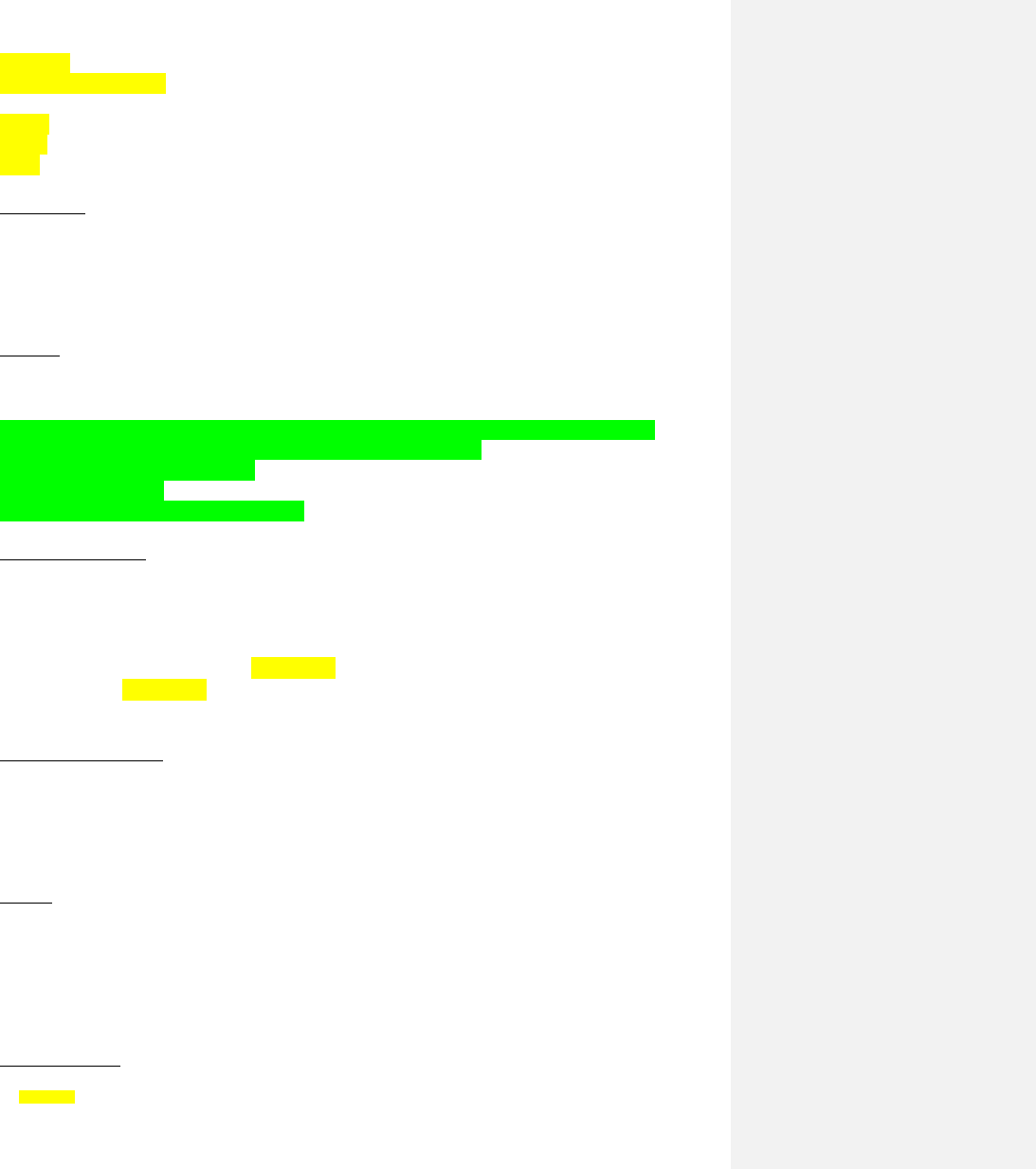
1
7
-
0XX
-
C1
21
Rev
10/14/16
[Address]
[City, State Zip Code]
Phone:
Email:
FAX:
37. Severability
If any provision of this Agreement is held to be illegal, invalid, or unenforceable, in whole or in part,
such provision shall be modified to the minimum extent necessary to make it legal, valid, and
enforceable, and the legality, validity, and enforceability of the remaining provisions shall not be
affected thereby.
38. Survival
The following sections survive expiration or termination of this Agreement:
Section 17 (Written and Electronic Versions of Work Products and Related Work Materials)
Section 18 (Ownership, Confidentiality, and Use of Work Products)
Section 24 (Release of Information)
Section 26 (Indemnity)
Section 29 (Records Retention and Audits)
39. Order of Precedence
In the event of any conflict between the terms of this Agreement and the terms of any Exhibit, the
terms of the Agreement shall control. In the event of any conflict between the following documents,
the order of precedence shall be as follows:
• Amendment(s) to Contract No. 17-0XX-C1
• Contract No. 17-0XX-C1
• Exhibits
40. Jurisdiction and Venue
This Agreement shall be deemed an Agreement under the laws of the State of California, and for all
purposes shall be interpreted in accordance with such laws. Both Parties hereby agree and consent to
the exclusive jurisdiction of the courts of the State of California and that the venue of any action
brought thereunder shall be Los Angeles County, California.
41. Waiver
No delay or failure by either Party to exercise or enforce at any time any right or provision of this
Agreement shall be considered a waiver thereof of such Party’s right thereafter to exercise or enforce
each and every right and provision of this Agreement. A Waiver to be valid shall be in writing but
need not be supported by consideration. No single waiver shall constitute a continuing or
subsequent waiver.
42. Standard of Care

1
7
-
0XX
-
C1
22
Rev
10/14/16
Consultant shall perform the services under this Agreement in accordance with generally accepted
industry standards, practices, and principles applicable to such services. Without waiver of SCAG’s
other rights or remedies, SCAG may require Consultant to re-perform any of said services which
were not performed in accordance with these standards at no cost to SCAG.
43. Insurance
Consultant shall procure and maintain throughout the Term of this Agreement the minimum required
insurance, as set for below, against claims for injuries to persons, or damages to property, which may
arise from or in connection with the performance of the work hereunder by Consultant, its subcontracts,
agents, representatives, or employees.
a. Minimum Scope of Insurance – Coverage shall be at least as broad as:
(1) Insurance Services Office Commercial General Liability coverage (Occurrence form CG0001),
or its equivalent.
(2) Insurance Services Office form number CA0001 (Ed. 1/87) covering Automobile Liability, code
1 (any auto) or its equivalent.
(3) Workers’ Compensation insurance as required by the State of California and Employer’s
Liability Insurance.
(4) Professional Liability (Errors and Omissions) insurance appropriate to the Consultant’s
profession.
b. Minimum Limits of Insurance – Consultant shall maintain limits no less than:
(1) General Liability: $1,000,000 per occurrence for bodily injury, personal injury and property
damage. If Commercial General Liability Insurance or other form with a general aggregate
limit is used, either the general aggregate limit shall apply separately to this project/location or
the general aggregate limit shall be twice the required occurrence limit.
(2) Automobile Liability: Including contractual liability insuring owned, non-owned, hired and all
vehicles by Consultant with a combined single limit of not less than $1,000,000 applicable to
bodily injury, or death, and loss of or damage to property in any one occurrence.
(3) Workers’ Compensation Liability: Including Occupational Diseases in accordance with
California Law and Employers’ Liability Insurance with a limit of not less than $1,000,000 each
accident.
(4) Professional Liability Insurance: With limits of not less than $1,000,000 per claim and
aggregate. In addition, it shall be required that the professional liability insurance policy remain
in effect for six (6) months after the Completion Date of this Agreement.
c. Other Insurance Provisions – The general liability and automobile liability policies are to contain, or
be endorsed to contain, the following provisions:
(1) SCAG, its subsidiaries, officials and employees are to be covered as additional insureds, as
respects to liability arising out of the activities performed by or on behalf of Consultant,

1
7
-
0XX
-
C1
23
Rev
10/14/16
products and completed operations of Consultant; premises owned, occupied or used by
Consultant; or automobiles owned leased, hired or borrowed by Consultant. The coverage shall
contain no special limitations on the scope of protection afforded to SCAG, its members,
subsidiaries, officials and employees.
(2) For any claims related to this project, Consultant’s insurance coverage shall be primary
insurance as respects SCAG, its members, subsidiaries, officials and employees. Any insurance
or self-insurance maintained by SCAG shall be excess of Consultant’s insurance and shall not
contribute with it.
(3) Any failure to comply with reporting or other provisions of the policies including breaches of
warranties shall not affect coverage provided to SCAG, its members, subsidiaries, officials and
employees.
(4) Consultant’s insurance shall apply separately to each insured against whom claim is made or
suit is brought, except with respect to the limits of the insurer’s liability.
(5) Workers’ Compensation and Employer’s Liability policies shall contain the inclusion of SCAG,
its members, subsidiaries, officials and employees and shall provide a waiver of subrogation.
d. Deductibles and Self-Insured Retentions – Any deductibles or self-insured retentions in amounts
over $10,000 must be declared to and approved by SCAG.
e. Acceptability of Insurers – Insurance is to be placed with California admitted insurers with a current
A.M. Best’s rating of no less than A and be admitted, unless otherwise approved by SCAG.
f. Verification of Coverage – Consultant shall furnish SCAG with original endorsements and
certificates of insurance evidencing coverage required by this clause. All documents are to be
signed by a person authorized by that insurer to bind coverage on its behalf. All documents are to
be received and approved by SCAG before work commences. Upon request of SCAG at any time,
Consultant shall provide complete, certified copies of all required insurance policies, including
endorsements affecting the coverage required by these specifications.
44. Force Majeure
Neither SCAG nor Consultant shall be liable or deemed to be in default for any delay or failure in
performance under this Agreement or interruption of services resulting, directly or indirectly, from acts
of God, civil or military authority, acts of public enemy, war, strikes, labor disputes, or any other similar
cause beyond the reasonable control of SCAG or Consultant.
45. Entire Agreement
This writing contains the entire agreement of the Parties relating to the subject matter hereof, and the
Parties have made no agreements, representations or warranties relating to the subject matter hereof
which are not set forth herein. Except as provided herein, this Agreement may not be modified or
altered without formal written amendment thereto.
46. Execution of Agreement or Amendment
This Agreement, or any amendment related thereto (Amendment), may be executed in multiple

1
7
-
0XX
-
C1
24
Rev
10/14/16
counterparts, each of which shall be deemed to be an original, but all of which shall constitute one
and the same agreement. The signature page of this Agreement or any Amendment may be executed
by way of a manual or authorized digital signature. Delivery of an executed counterpart of a
signature page to this Agreement or an Amendment by electronic transmission scanned pages shall
be deemed effective as a delivery of a manually or digitally executed counterpart to this Agreement
or any Amendment.
47. Effective Date
The Effective Date of this Agreement shall mean the date (meaning the last date indicated below)
that the Parties have fully executed this Agreement.
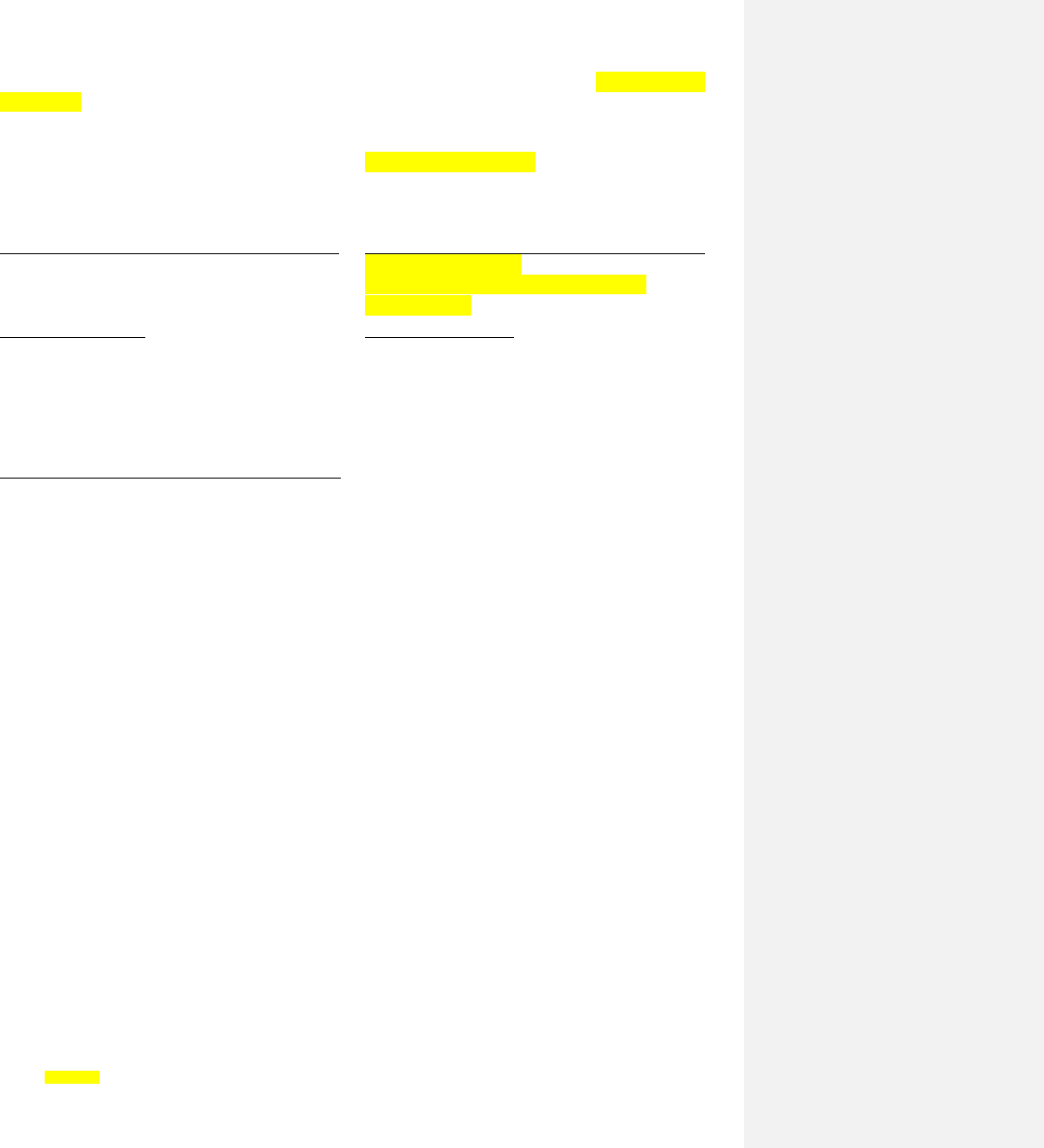
1
7
-
0XX
-
C1
25
Rev
10/14/16
IN WITNESS WHEREOF, the Southern California Association of Governments and [insert Name of
Consultant] have caused this Agreement to be executed by their duly authorized representatives.
Southern California Association of Governments
Insert Company’s Name
(“SCAG”) (“Consultant”)
Basil Panas Insert Name of Person
Chief Financial Officer Title of Person – authorized to bind/sign
for the company
Date Date
Approved as to Legal Form:
Joanna Africa
Chief Counsel/Director of Legal Services

EXHIBIT A
Scope of Work

Exhibit A – Scope of Work
1
7
-
0XX
-
C1
27
Rev
10/14/16
The consultant shall perform the following Tasks.
Insert Scope of Work here
Deliverables shall be provided in accordance with Exhibit B, Schedule.

EXHIBIT B
Schedule

Exhibit B – Schedule
1
7
-
0XX
-
C1
29
Rev
10/14/16
Insert schedule here.

EXHIBIT C
Line Item Budget
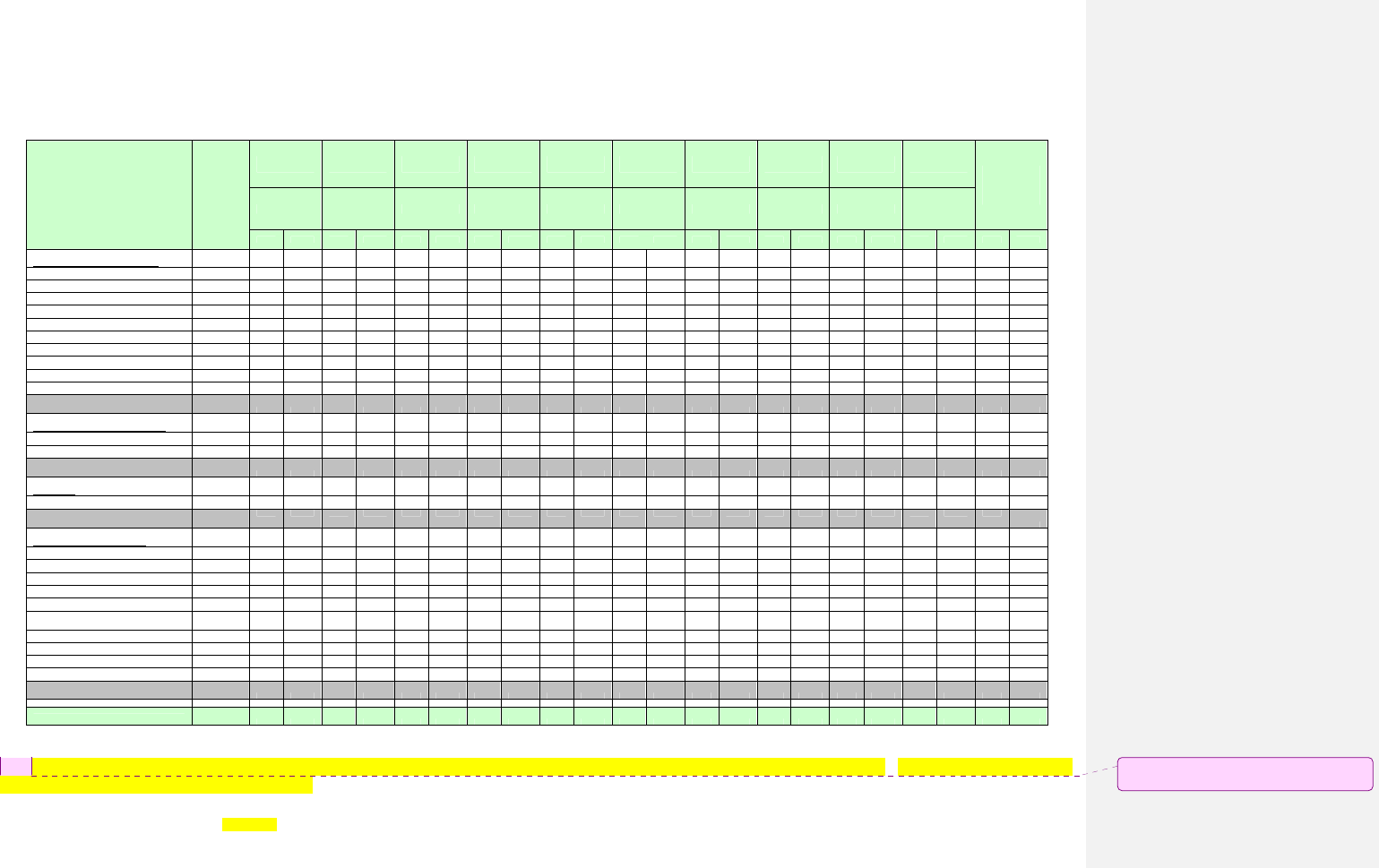
Exhibit C – Line Item Budget
1
7
-
0XX
-
C1
31
Rev
10/14/16
Consultant: ABC Company Title of RFP: ______________________________________________
1234 Main Street, Suite 100
Los Angeles, CA 90000 RFP Number: ______________________________________________
(213) 555-5555
(a) (b) (c) (d) (e) (f) (g) (h) (i) (j) (k) (l) (m) (n) (o) (p) (q) (r) (s) (t) (u) (v) (w) (x)
Cost Categories
Maximum
Hourly
Rate
Task 1 Task 2 Task 3 Task 4 Task 5 Task 6 Task 7 Task 8 Task 9 Task 10
Grand
Total
(All Tasks)
TBD TBD TBD TBD TBD TBD TBD TBD TBD TBD
Hours Amount Hours Amount Hours Amount Hours Amount Hours Amount Hours Amount Hours Amount Hours Amount Hours Amount Hours Amount Hours Amount
Direct Labor Classification(s):
$0
$ - $0 $0 $0 $0 $0 $0 $0 $0 $0 $0 0 $0
$ - $0 $0 $0 $0 $0 $0 $0 $0 $0 $0 0 $0
$ - $0 $0 $0 $0 $0 $0 $0 $0 $0 $0 0 $0
$ - $0 $0 $0 $0 $0 $0 $0 $0 $0 $0 0 $0
$ - $0 $0 $0 $0 $0 $0 $0 $0 $0 $0 0 $0
$ - $0 $0 $0 $0 $0 $0 $0 $0 $0 $0 0 $0
$ - $0 $0 $0 $0 $0 $0 $0 $0 $0 $0 0 $0
$ - $0 $0 $0 $0 $0 $0 $0 $0 $0 $0 0 $0
$ - $0 $0 $0 $0 $0 $0 $0 $0 $0 $0 0 $0
$ - $0 $0 $0 $0 $0 $0 $0 $0 $0 $0 0 $0
Subtotal - Direct Labor
0 $0 0 $0 0 $0 0 $0 0 $0 0 $0 0 $0 0 $0 0 $0 0 $0 0 $0
Overhead & Fringe (inc. G&A):
$0
$0 $0 $0 $0 $0 $0 $0 $0 $0 $0 $0
$0 $0 $0 $0 $0 $0 $0 $0 $0 $0 $0
Subtotal - Overhead & Fringe (inc G&A):
$0 $0 $0 $0 $0 $0 $0 $0 $0 $0 $0
Fixed Fee
$0
$0 $0 $0 $0 $0 $0 $0 $0 $0 $0 $0
Subtotal - Fixed Fee:
$0 $0 $0 $0 $0 $0 $0 $0 $0
$0
Other Direct Costs ( ODCs)
$0
Travel
$ - $0 $0 $0 $0 $0 $0 $0 $0 $0 $0 0 $0
Printing – Directly Chargeable Only
$ - $0 $0 $0 $0 $0 $0 $0 $0 $0 $0 0 $0
Other
$ - $0 $0 $0 $0 $0 $0 $0 $0 $0 $0 0 $0
Other
$ - $0 $0 $0 $0 $0 $0 $0 $0 $0 $0 0 $0
$ - $0 $0 $0 $0 $0 $0 $0 $0 $0 $0 0 $0
Subconsultant(s)*
$0
$ - $0 $0 $0 $0 $0 $0 $0 $0 $0 $0 0 $0
$ - $0 $0 $0 $0 $0 $0 $0 $0 $0 $0 0 $0
$ - $0 $0 $0 $0 $0 $0 $0 $0 $0 $0 0 $0
$ - $0 $0 $0 $0 $0 $0 $0 $0 $0 $0 0 $0
Subtotal - ODCs
:
$0 $0 $0 $0 $0 $0 $0 $0 $0 $0 $0
Grand Total
0 $0 0 $0 0 $0 0 $0 0 $0 0 $0 0 $0 0 $0 0 $0 0 $0 0 $0
* if you anticipate the use of subconsultants, use a copy of this template to identify subconsultant cost detail by task in a similar fashion and input final figures under each subconsultant (Hours & Amount by tasks involved)
Note: SCAG intent is to pay upon task completion. However, proposers may propose a payment schedule for SCAG’s consideration. Also SCAG does not allow
the Prime any mark up on subconsultant costs.
Comment [N7]:
Delete this sentence if you
are issuing a CPFF contract.

1
7
-
0XX
-
C1
32
Rev
10/14/16
Exhibit C1 – Line Item Budget/Price Sheet
SCAG shall pay the consultant a firm fixed price for each task, upon its completion (a percentage of
complete can be negotiated). The price quoted must be all inclusive (i.e., direct labor, overhead, fringes,
fee, Other Direct Costs…)
Tasks
No.
Task Description Cost
Percentage
of overall
Price
1
TBD (e.g. General Administration, Task Meetings)
2
TBD
3
TBD
4
TBD
Add or delete more rows as necessary
Total Cost:
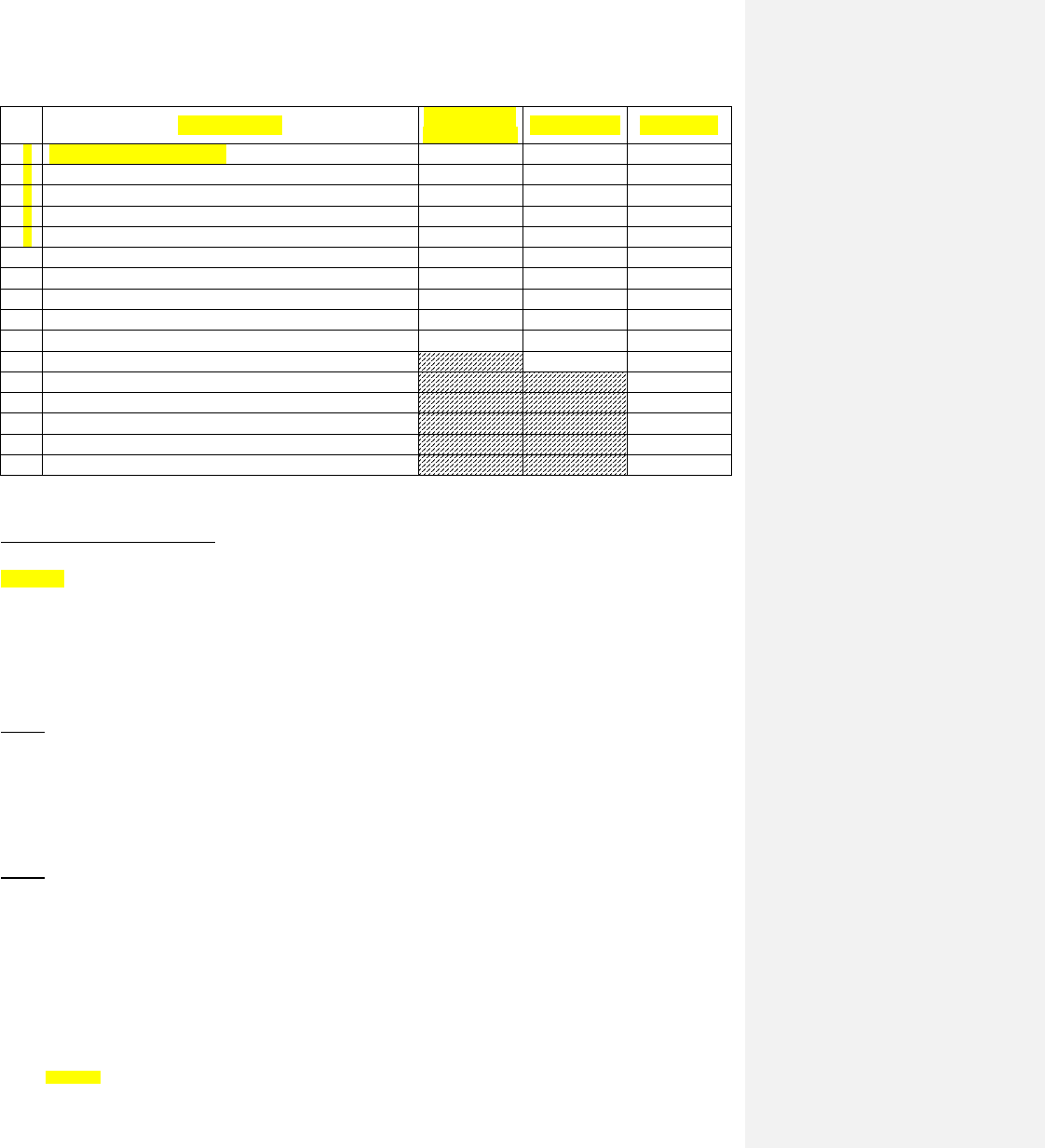
1
7
-
0XX
-
C1
33
Rev
10/14/16
Exhibit C1 – Consultnt’s Cost Breakdown
1
Staff Member
Hourly Rate
(fully burdened)
Total Hours
Total Cost
1
).
Prime Staff - Name, Title
2
).
3
).
4
).
5
).
6).
Sub Staff - Name, Title
7).
8).
9).
10).
Direct Labor Sub Total
:
Prime - Other Direct Cost (with no mark-up)
Sub 1 - Other Direct Cost (with no mark-up)
Sub 2 - Other Direct Cost (with no mark-up)
ODC’s Sub Total:
Cumulative Total
1
This Exhibit C1 is provided for cost/price analysis purposes. Actual costs may vary so long as the total cost does not
exceed the price you propose.
Breakdown of Other Direct Costs
Prime, Consultant:
Examples
4 trips, air fare @ $377 = $1,508
4 trips: travel to/from airports = $760
9 nights hotel @$110 = $990
10 days per diem @ $34 = $306
Total: $3,600
Sub 1:
4 trips, air fare @ $278 = $1112
4 trips: travel to/from airports = $760
12 nights hotel @$110 = $1320
12 days per diem @ $34 = $408
Total: $3,600
Sub 2:
4 trips, air fare @ $235 = $940
4 trips: travel to/from airports = $760
7 nights hotel @ $110 = $770
10 days per diem @ $34 = $340
Total: $2,800
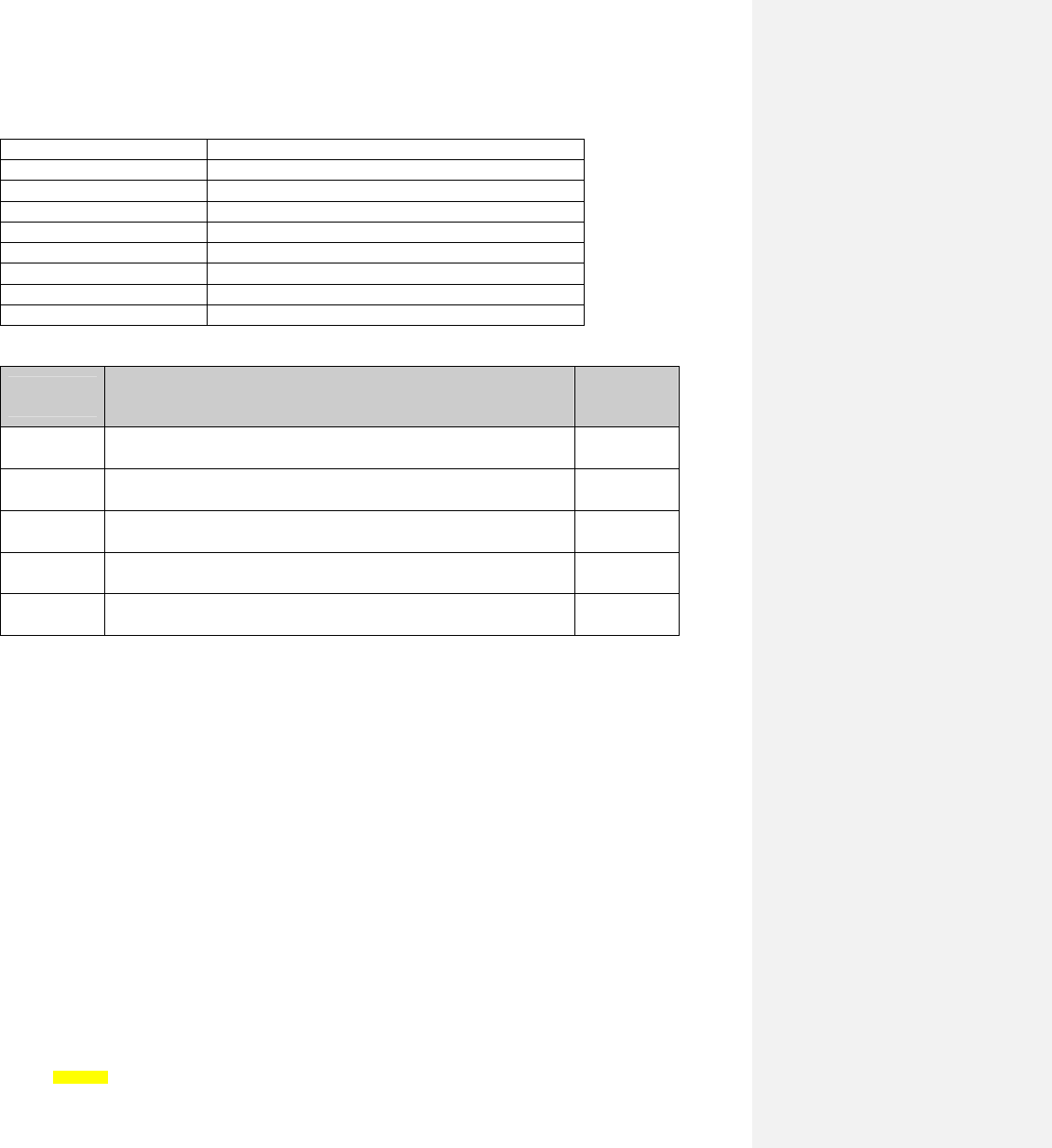
1
7
-
0XX
-
C1
34
Rev
10/14/16
Exhibit C2
Fixed Price Contract Invoice Format
Firms Name:
Address Line1:
Address Line 2:
Contact Phone Number:
E-mail:
SCAG Contract #:
SCAG Project Title:
SCAG Project/Task #:
Deliverable
Number
Deliverable Description
(attach Progress Report to support each)
Milestone
Payment
Amount
1 $13,429
2
3
4

EXHIBIT D
Contract Funding/Expenditure Summary
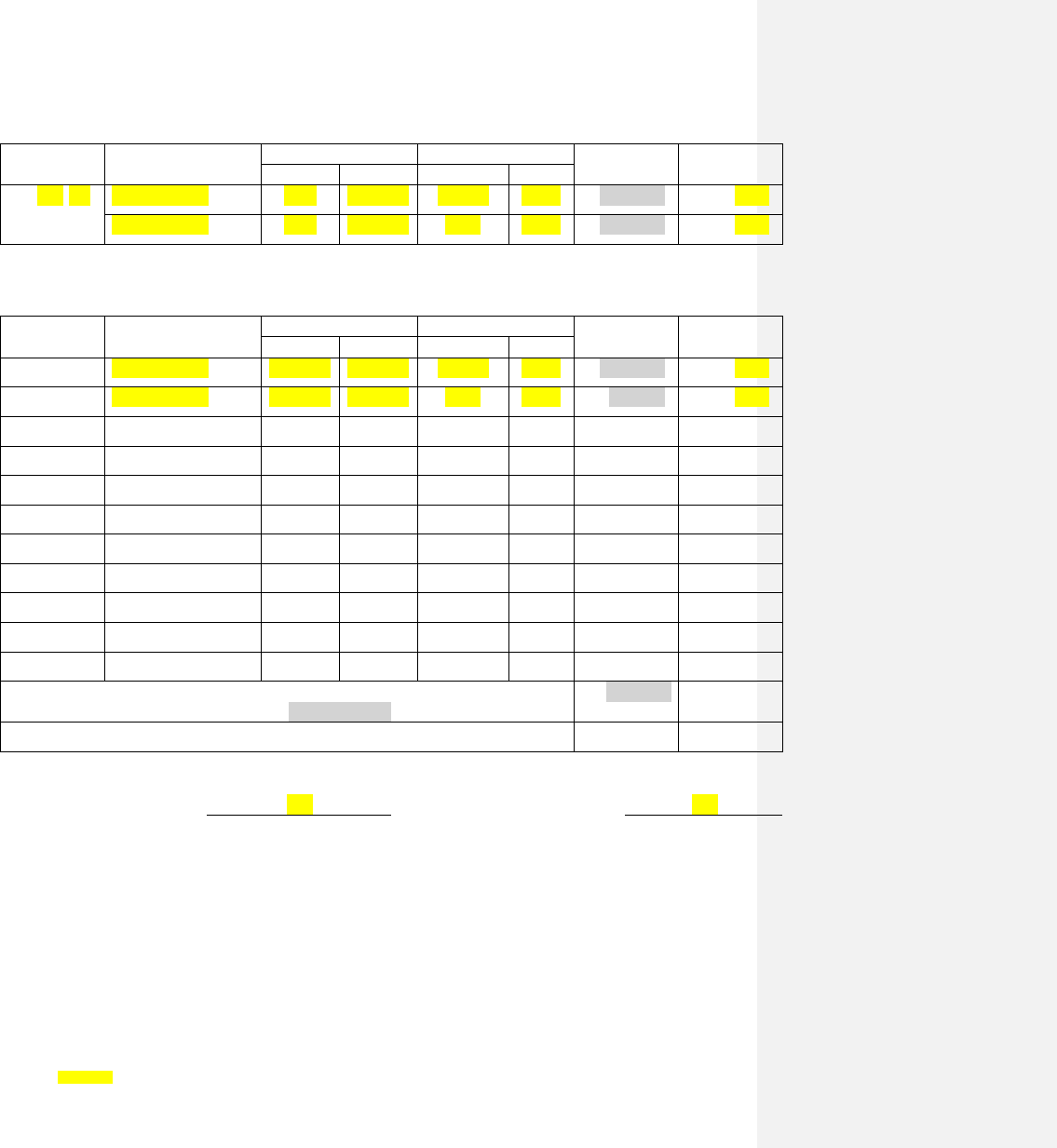
Exhibit D - Contract Funding/Expenditure Summary
1
7
-
0XX
-
C1
36
Rev
10/14/16
Original (base) Award:
Contract
Number
Project
Number
Funding Period Funding
Funding
Amount
Expenditure
Amount
From To Source %
15-???-C1
070.SCGC5.2 NTP 06/30/15
FHWA 88.53 $300,000 TBD
810.SCGC3.2 NTP 06/30/15
TDA 11.47 $100,000 TBD
Amendment(s):
#
Project
Number
Funding Period Funding
Funding
Amount
Expenditure
Amount
From To Source %
1 810.SCGC3.2 07/01/14
06/30/15
FHWA 88.53 $100,000 TBD
2 810.SCGC3.2 07/01/14
06/30/15
TDA 11.47 $50,000 TBD
Total Contract Funding Amount to Date:
This total is a cumulative of the numbers shaded in grey above.
$550,000
Total Contract Value to Date:
$550,000
Purchase Order Number:
???
Vendor Number:
???

EXHIBIT E
Spatial Data/Metadata Requirements
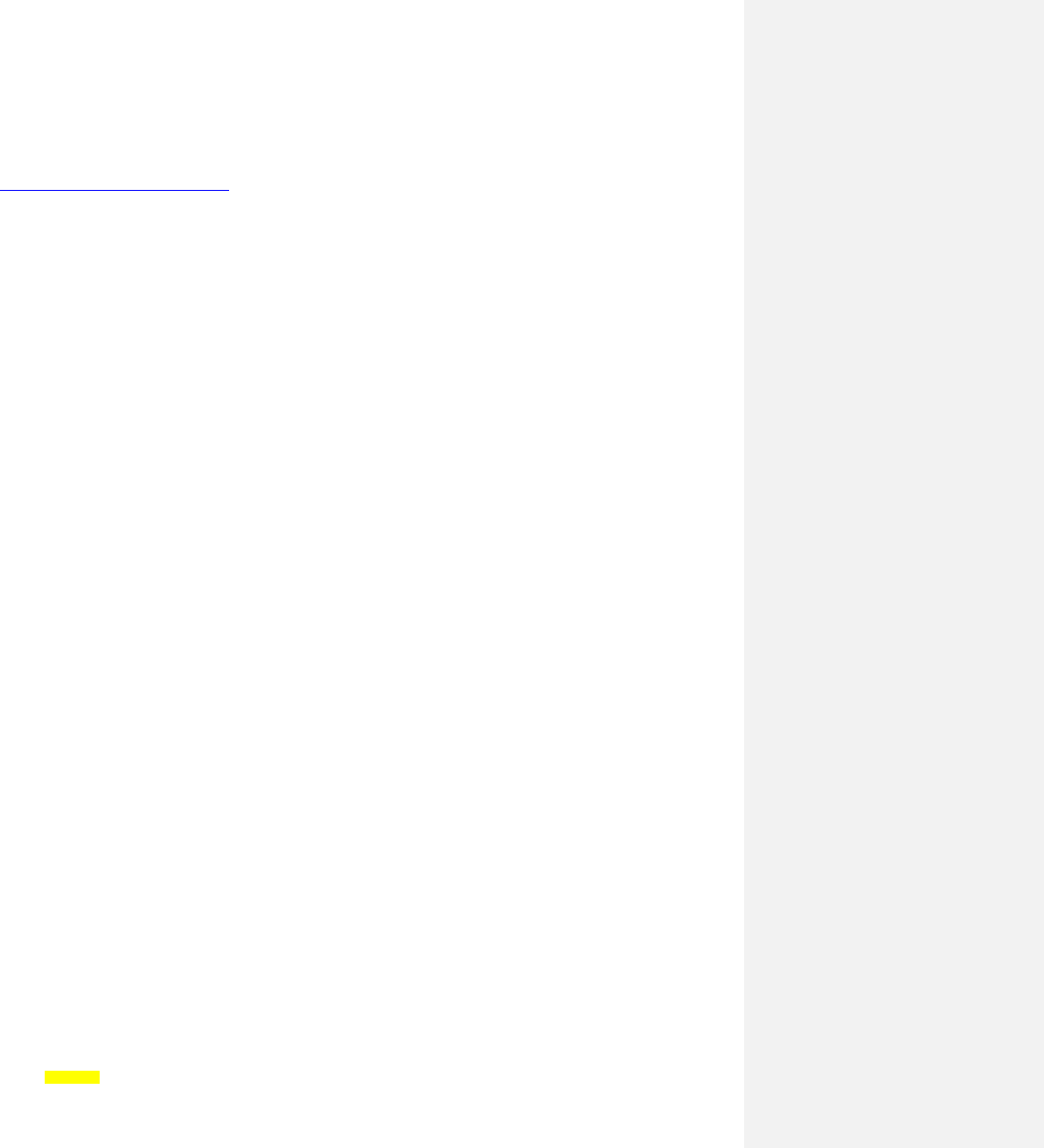
Exhibit E - Spatial Data/Metadata Requirements
1
7
-
0XX
-
C1
38
Rev
10/14/16
The following are fields required for documentation of data received by SCAG. The metadata
documentation follows that presented in FGDC-STD-001-1998 “Content Standard for Digital
Geospatial Metadata,” commonly referred to as the FGDC standard.
http://www.fgdc.gov/metadata
A number of these metadata fields require prior consideration between SCAG and contractors
before data acquisition or collection begins. These are:
1. Progress
SCAG requires that a contractor indicate the anticipated progress of all datasets upon project
completion. Explanations should be prepared for any datasets that are not complete at the close of
the contract.
2. Access Constraints
Any anticipated constraints on access to datasets need to be documented and agreed to by SCAG
before data collection or acquisition begins. Any licensing requirements should be spelled out here.
3. Use Constraints
Any anticipated constraints on use of data sets need to be documented and agreed to by SCAG
before data collection or acquisition begins. Any licensing requirements should be spelled out here.
4. Security Classification
Any anticipated sensitivities of the data set or security implications of the dataset need to be
documented and agreed to by SCAG before data collection or acquisition begins. This applies to
general sensitivity issues and not strictly national security classification systems. For example,
SCAG needs to know that the data being collected is sensitive to the extent that it should not be
displayed at large scales on the Internet.
5. Native Data Set Environment
The data set format needs to be documented and agreed to by SCAG before data collection or
acquisition begins. SCAG works primarily with standard ESRI formats like shapes and coverages.
6. Attribute Accuracy Value
The accuracy of attributes needs to be documented and agreed to by SCAG before data collection or
acquisition begins. For example, if elevations are being collected SCAG needs to be informed that
they will be plus or minus 50 feet.
7. Horizontal Positional Accuracy Value
The horizontal positional accuracy needs to be documented and agreed to by SCAG before data
collection or acquisition begins. For example, if point locations are being recorded from a GPS
receiver, SCAG needs to be aware that 90% of the points are within 30 meters of true ground
position.
8. Source Currentness Reference
SCAG needs to be informed if the currentness reference is not ground condition. The currentness
reference is the basis on which the time period content is determined. The date of the data set can be
based on a number of things such as publication date, release date, or delivery date. An example

Exhibit E - Spatial Data/Metadata Requirements
1
7
-
0XX
-
C1
39
Rev
10/14/16
would be the 2000 Thomas Brothers centerline file. The date usually associated with this file is the
year indicated on the “Thomas Guide” that the digital data was used to create. It is much more likely
that the data actually represents some time in 1999, since the books came out in time for Christmas
1999. The currentness reference in this case could be Thomas Guide title date.
9. Horizontal Coordinate System Definition
SCAG needs to know and agree to the data projection. It would be very unusual to accept a
projection that does not have standard parameters. Data will most often be required in North
American Datum 1983 UTM zone 11. The parameters for this projection are:
Projection: Transverse Mercator
Parameters
False Easting 500000.0000000
False Northing: 0.0000000
Central Meridian: -117.0000000
Scale_Factor: 0.999600000
Latitude of Origin: 0
Linear Unit: Meter (1.000)
Geographic Coordinate System:
Name: GCS_North_American_1983
Angular Unit: Degree (0.017453292519943295)
Prime Meridian: Greenwich (0.000000000000)
Datum: D_North_American_1983
Spheroid: GRS_1980
Semimajor Axis: 6378137.000000000000
Semiminor Axis: 6356752.314140356100
Inverse Flattening: 298.2572221010000200
SCAG also requires all codes used in any spatial data set to be provided in an agreed upon electronic
format.
The FGDC standard for data documentation is a very complete standard covering every kind of
spatial data. What follows are the items for metadata documentation in datasets typically
received at SCAG. Generally SCAG receives data pertaining to phenomena on the earth’s
surface in a vector form of points, lines, or polygons. Other types of data, which might include
such forms as raster data and imagery data or some theme as subsurface water depth, would
require reconsideration of some of the specific items required. The types of metadata
information outlined at the first and second levels below are required of all data.
The outline numbers are from FGDC-STD-001-1998 “Content Standard for Digital Geospatial
Metadata.” The actual fields that require input are underlined
1. Identification Information
1.1 Citation

Exhibit E - Spatial Data/Metadata Requirements
1
7
-
0XX
-
C1
40
Rev
10/14/16
1.2 Description
1.2.1 Abstract – Brief narrative summary of the dataset (Required)
1.2.2 Purpose - Intentions for which the dataset was acquired/developed (Required)
1.2.3 Supplemental Information – Any information not elsewhere documented that will
give insight into the dataset. (Optional)
1.3 Time Period of Content
1.4 Status
1.4.1 Progress – The state of the data set. An explanation is required if the final progress for a
dataset received due to a contract is not “Complete.” (Required).
1.4.2 Update Frequency – The frequency with which changes to the dataset are made
(Required).
1.5 Spatial Domain
1.5.1 Bounding Coordinates
1.5.1.1 West - Most Western boundary (Required – SCAG will accept in Projection Units if
a standard projection is used).
1.5.1.2 East - Most Eastern boundary (Required – SCAG will accept in Projection Units if a
standard projection is used).
1.5.1.3 North – Most Northern boundary (Required – SCAG will accept in Projection Units
if a standard projection is used).
1.5.1.4 South – Most Southern boundary (Required - – SCAG will accept in Projection
Units if a standard projection used).
1.6 Keywords
1.6.1 Theme
1.6.1.2 Theme keyword/s – Keyword or words describing theme (Required)
1.6.2 Place
1.6.2.1 Place keyword/s – Keyword or words describing location (Required)
1.7 Access Constraints – Restrictions and legal prerequisites for accessing the dataset (Required)

Exhibit E - Spatial Data/Metadata Requirements
1
7
-
0XX
-
C1
41
Rev
10/14/16
1.8 Use Constraints – Restrictions and legal prerequisites for using the data after access is granted
(Required).
1.9 Point of Contact
1.12 Security Information
1.12.2 Security Classification – Any restrictions imposed by national security concerns. Must
be agreed upon before data acquisition. SCAG will accept non-traditional evaluations of
confidentiality that a contractor may deem appropriate. A dataset for example may be
classified “may be inappropriate for display on Internet at large scales.” These evaluations
are for security concerns not data quality concerns. (Required)
1.13 Native Data Set Environment – Software and format in the producers processing environment.
The contractor is considered the producer even if data has been acquired form another source.
(Required)
2. Data Quality Information
2.1 Attribute Accuracy
2.1.1 Attribute Accuracy Report – an explanation of the accuracy of assigned values in the data
set (if applicable)
2.1.2 Quantitative Attribute Accuracy Assessment
2.1.2.1 Attribute Accuracy Value – an estimate of the accuracy assigned values in the data
set (if applicable)
2.1.2.2 Attribute Accuracy Explanation – and identification of the test that produced the
Attribute Accuracy Value (if applicable)
2.4 Positional Accuracy
2.4.1 Horizontal Positional Accuracy
2.4.1.1 Horizontal Positional Accuracy Report – an explanation of the accuracy of the
horizontal coordinate measurements (if applicable)
2.4.1.2 Quantitative Horizontal Positional Accuracy Assessment
2.4.1.2.1 Horizontal Positional Accuracy Value – numeric value assigned to
summarize the accuracy of the horizontal coordinate measurements
(Required)
2.4.1.2.2 Horizontal Positional Accuracy Explanation – the test that produced the
Horizontal Positional Accuracy Value (if applicable)

Exhibit E - Spatial Data/Metadata Requirements
1
7
-
0XX
-
C1
42
Rev
10/14/16
2.5 Lineage
2.5.1 Source Information
2.5.1.1 Source Citation
2.5.1.2 Source Scale Denominator – the denominator of the representative fraction of the
source map or the scale representative of the accuracy of the digital product (e.g. a
scale of 1:24,000 is 24000) (Required)
2.5.1.3 Type of Source Media – media of the source dataset (if applicable - digitized data
would have the Type of Source Media reported as “paper”)
2.5.1.4 Source Time Period of Content
2.5.1.4.1 Source Currentness Reference – The basis on which the time period
content (9.1.1 Calendar Data, or 9.3.1 Beginning Date/9.3.3 Ending Date)
is determined. Most acceptable is “ground condition.” This
feature/condition exited on the ground in the time period specified. Other
currentness references (publication date, date acquired from agency,) need
to be discussed with SCAG. (Required).
3. Spatial Data Organization Information
3.1 Indirect Spatial Reference – name of means through which locations are referenced in the
dataset. Pertains to mechanisms like geocoding addresses or linear referencing systems. (if
applicable)
3.2 Direct Spatial Reference – type of object used to represent space in the data set (e.g. Point, Line,
Polygon) (Required)
4. Spatial Reference Information
4.1 Horizontal Coordinate System Definition
4.1.1 Geographic
4.1.1.1 Geographic Coordinate Units (Required if geographic)
4.1.2 Planar
4.1.2.1 Map projection
4.1.2.1.1 Map Projection Name (Required if planar system, if standard projection is
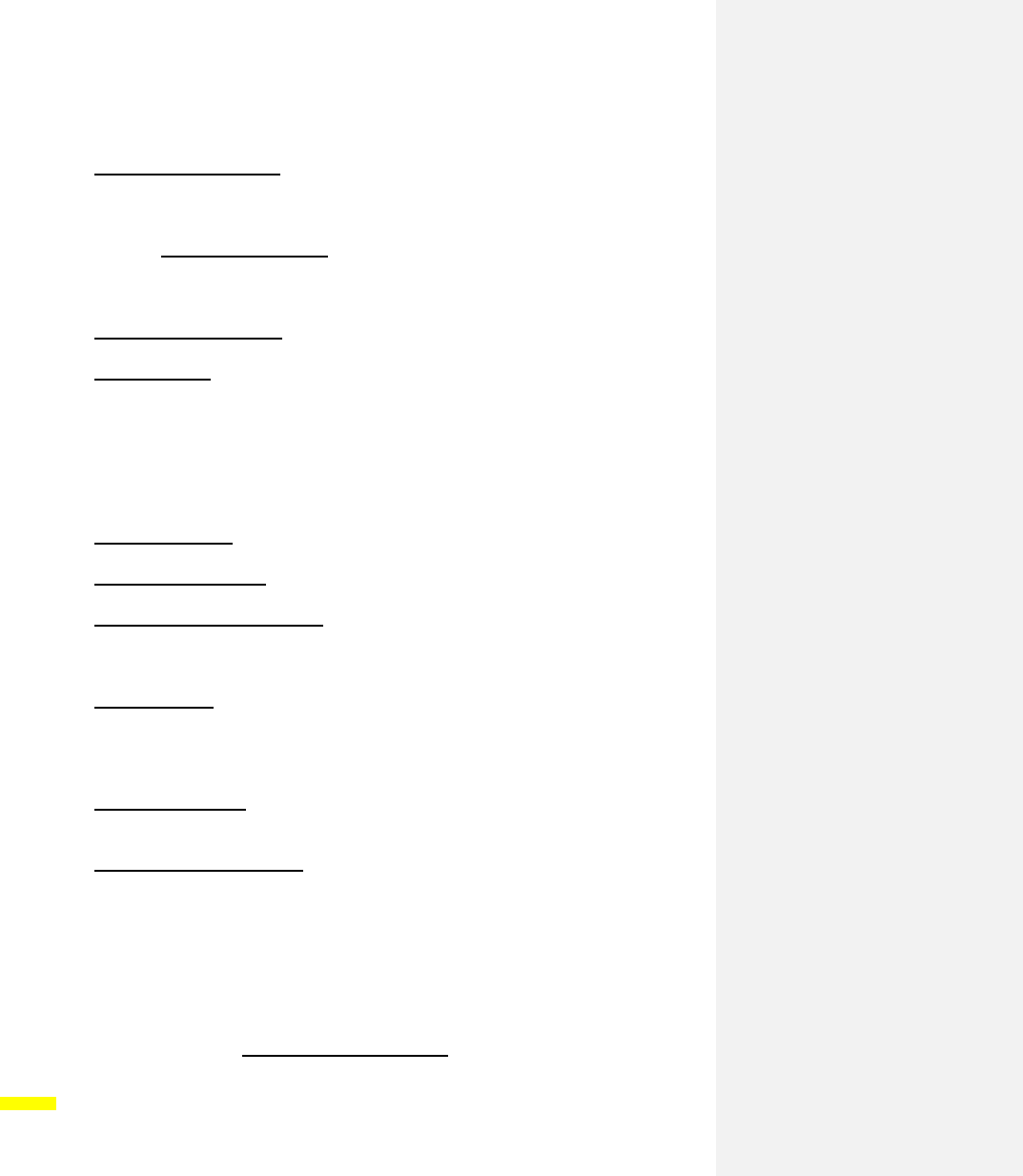
Exhibit E - Spatial Data/Metadata Requirements
1
7
-
0XX
-
C1
43
Rev
10/14/16
used place it here. Most acceptable is NAD_1983_UTM_Zone_11N.)
4.1.2.2 Grid Coordinate System (Required if planar system and not standard)
4.1.2.3 Planar Coordinate Information
4.1.2.3.1 Planar Distance Units (Required if planar system and not standard)
4.1.4 Geodetic Model
4.1.4.1 Horizontal Datum Name (Required if not standard)
4.1.4.2 Ellipsoid Name (Required if not standard)
5. Entity and Attribute Information
5.1 Detailed Description
5.1.1 Entity Type (for each)
5.1.1.1 Entity Type Label – the name of the entity type (e.g. integer, text)(Required)
5.1.1.2 Entity Type Definition – the definition of the entity type (if necessary)
5.1.1.3 Entity Type Definition Source – the source of the definition (if necessary)
5.1.2 Attribute (for each)
5.1.2.1 Attribute Label – Name in file (Required for non-standard attributes. Standard
attributes are those produced by software. For example, a polygon coverage
produced by ESRI software will have such fields as perimeter and area that are
created and maintained by the system)
5.1.2.2 Attribute Definition – What the attribute represents (Required for non-standard
attributes)
5.1.2.3 Attribute Definition Source – Authority of the field definition. This could be a
citation to a document or the group responsible for the field. (e.g. The U.S. Census
Bureau is the authority for the definition of the field P1 which is Population)
(Required for non-standard attributes)
5.1.2.4 Attribute Domain Values
5.1.2.4.1 Range Domain
5.1.2.4.1.1 Attribute Units of Measure – the standard of measurement
(Required if range)

Exhibit E - Spatial Data/Metadata Requirements
1
7
-
0XX
-
C1
44
Rev
10/14/16
5.1.2.4.1.2 Attribute Measurement Resolution – the smallest unit to
which an attribute value is measured (if applicable)
5.1.2.4.2 Codeset Domain Codes – must be supplied in a digital file
5.1.2.4.2.1 Codeset Name (Required if codeset)
5.1.2.4.2.2 Codeset Source (Required if codeset)
5.1.2.5 Attribute Value Accuracy Information
5.1.2.5.1 Attribute Value Accuracy – an estimate of the accuracy of attribute
values (Required if applicable)
5.1.2.5.2 Attribute Value Accuracy Explanation – how the Attribute Value
Accuracy was derived (Required if applicable)
5.1.2.6 Attribute Measurement Frequency – the frequency that the measurements are
added (Required if applicable)
6. Metadata Reference Information
6.1 Metadata Date – the date the metadata was created or last updated (Required)
6.2 Metadata Contact – the party responsible for the metadata information. (Required)
7. Citation Information
7.1 Originator – name of organization or individual that developed the dataset (Required).
7.2 Publication Date – the date the data was published or made available for release (Required).
7.3 Other Citation Details (Optional)
8. Time Period of Content
8.1 Single Date/Time – the year or portion of year (e.g. month) for which the data corresponds to the
Currentness Reference. SCAG does not anticipate that time will be a factor in metadata for
information typically collected for this agency.
8.1.1 Calendar Date – the year and optionally month (Required if not reported within 9.3 Range
of Dates/Times)
8.2 Range of Dates/Times – the range of years or portion of years (e.g. month) for which the data
corresponds to the Currentness Reference. SCAG does not anticipate that time will be a factor in

Exhibit E - Spatial Data/Metadata Requirements
1
7
-
0XX
-
C1
45
Rev
10/14/16
metadata for information typically collected for this agency.
8.2.1 Beginning Date – the first year and optionally month (Required if not reported as 9.1.1
Calendar Date)
8.2.2 Ending Date – the last year and optionally month (Required if not reported as 9.1.1
Calendar Date)
9. Contact Information
9.1 Contact person primary
9.1.1 Contact Person (Required if person is best mechanism to report contact)
9.1.2 Contact Organization (Required if person is best mechanism to report contact)
9.2 Contact Organization (Required if not reported as 10.1 Contact person primary)
9.3 Contact Voice Phone (Required)
9.4 Contact Fax Phone (Optional)
9.5 Contact E-mail (If available)
9.6 Contact Instructions – supplemental information, which might include web sites and other
mechanisms for contact (Optional).

EXHIBIT F
Graphics Requirements for Consultants

Exhibit F - Graphics Requirements for Consultants
1
7
-
0XX
-
C1
47
Rev
10/14/16
For the Web
Please provide in the following:
• All Documents in PDF format
• All Graphics in JPEG format, 72 dpi, RGB mode for photos
• All Logos in EPS format and GIF or PNG format for use on the web
• Include all original high-resolution graphics and fonts that were used to create the web page or
layout
• If in HTML format, provide HTML documents/templates and all supporting CSS, GIFs and
JPEGs
For Print Projects
Documents
Acceptable formats: Save files in Microsoft Word, InDesign or QuarkXpress (InDesign/Quark files for
Windows are preferred)
• Be sure to include all fonts and imported JPEG, TIFF and EPS files
• Provide a PDF of the final document layout
• Provide a hard copy of the document in color
• Be sure to include all fonts – printer and system fonts
Photos Used in the Document
Be sure to provide high-resolution version of all photos for print use.
• Color photos – 300 dpi, CMYK scans in TIFF format or high resolution JPEGs
• Black and white 300 dpi Grayscale scans
• Include all composited photo collages or graphics such as layered Photoshop (.psd) files
• Photo credits: who took the photos, the location, appropriate captions
Charts/Graphs
• Be sure to include all linked files when providing Microsoft Excel files.
Logos and Other Graphics
• EPS files are preferred. When EPS is unavailable, high-resolution TIFF files may also be used.
• Include postal information such as bar codes, etc.
Photos of Meetings/Events/Location Shot
• We request that consultants provide SCAG with copies of all photos taken at subregional
meetings, conferences, or project sites. High-resolution TIFF or JPEG files from a digital
camera are preferred. Files may be sent on Flash drive disc or DVD-ROM. Traditional photo
prints and high-resolution scans are also acceptable.
Media Preference (if not sent via e-mail)
• Flash drive
• DVD-ROM (formatted for PC)
Documentation
• Be sure to include a directory list of the files

Exhibit F - Graphics Requirements for Consultants
1
7
-
0XX
-
C1
48
Rev
10/14/16
• Be sure to provide specific directions about printing the project including quantity, size, paper
stock (weight and color), color (Pantone, CMYK, B/W), one or two–sided printing, varnish,
bleed, trim, and binding
• Be sure to include your contact information (telephone, fax and e-mail). We want to be able to
contact you if we have specific questions or are missing files. Please provide us with deadline
and delivery instructions.
Files may also be e-mailed to: ha[email protected] Attn: Carolyn Hart. Please make sure that e-mailed
files are not larger than five megabytes. Files may also be compressed using WinZip or other
compression software.

EXHIBIT G
Web Policies & Guidelines for Consultants

Exhibit G - Web Policies & Guidelines for Consultants
1
7
-
0XX
-
C1
50
Rev
10/14/16
1. Tools and Requirements
Web staff uses these tools and applications for development and maintenance of SCAG’s site:
• Adobe Dreamweaver
• Adobe Photoshop
• Adobe Fireworks
• Javascript
• jQuery
• ColdFusion 6 (used for developing database-driven websites or applications)
• ASP, ASP.Net
• Perl
• Cascading Style Sheets
• SCAG uses IIS6
2. Web Development Process
Document Preparation:
• All documents should be converted to PDF and forwarded electronically to the Web staff. All
PDF files should be optimized for fast download.
• All software produced should be provided to SCAG with ANSI (American National Standards
Institute) compliant documentation. See www.ansi.org.
• Accessibility for Disabled Users. SCAG strives to make all of its Web resources accessible to
persons with disabilities in accordance with Federal law (Section 508). Development of new
content must meet Level 1 requirements. See Web Accessibility section. For more information
refer to www.w3.org/TR/WAI-WEBCONTENT/
3. Technical Standards
File Format:
• Text. Normal text on a Web page ensures the widest compatibility and fastest download. It also
assists search engines in indexing information on the website. Be sure to allow sufficient white
space for good readability. Avoid italicized fonts, as they are difficult to read.
• Multimedia. Unless necessary, keep audio and video files to a minimum. If used, subtitles
and/or a text transcript describing what was attached must be provided to Web staff. See the
Accessibility section for more information.
• A copy of the source code must be provided.
• Graphics. All graphics must be approved by the Graphics Department and conform to SCAG’s
standard layout and design. Requests for new graphics should be coordinated directly with
Carolyn Hart and meet these requirements:
• Avoid excessive use of graphic elements. Keep amount of text and graphics to a minimum for
easy viewing (less scrolling) and shorter download time. Break longer text documents into
multiple pages.
• If using images that serve a purpose on the page be sure to include a text description in the ALT
attribute so that visually impaired users can read the images. Refer to Web Accessibility section.

Exhibit G - Web Policies & Guidelines for Consultants
1
7
-
0XX
-
C1
51
Rev
10/14/16
• Graphics must be in JPEG format, 72 dpi, and RGB mode for photos.
• All logos must be in EPS format.
• Include all original higher resolution graphics and fonts that were used to create the Web page or
layout.
Link to SCAG’s site:
• All newly designed sites must include SCAG’s URL, www.scag.ca.gov on the main page for
easy navigation. SCAG’s URL should be prominently displayed at the top of each page.
Templates:
• SCAG standard layout and design templates must be used to maintain a consistent look and feel
of the website.
4. Quality Assurance Testing
• Conduct testing against specifications. Ensure that new development works as planned. Fix bugs
and limit changes here to bugs, unless absolutely important.
• Web Browser compatibility testing. Check to make sure that content is fully compatible with
major Web browsers which include Internet Explorer 7+, Firefox, Safari, Chrome and Lynx (text
based browser).
• Spell check. Make sure there are no spelling errors on the new content. Use Dreamweaver’s
built-in link check tool or purchase a third party service such as NetMechanic.
• Check for usability. Is the newly developed content understandable and intuitive?
• Accessibility check. Check the content against the Accessibility checklist provided. Do the
changes meet the requirements outlined in the checklist?
5. Production Process
Final testing/posting
• Once the site has been approved, it will be transferred to SCAG’s Web server. Web material will
be posted/accepted only upon final review and approval by SCAG Web staff.

EXHIBIT H
Mapping Guidelines for Consultants

Exhibit H – Mapping Guidelines for Consultants
1
7
-
0XX
-
C1
53
Rev
10/14/16
This document sets out some basic guidelines and “rules of thumb” that should always be considered
whenever consultant creates maps for SCAG-related projects. The guidelines cover three major areas:
procedural or process, physical presentation, and data presentation.
The main points of the procedural guidelines can be summarized as the need to work, early on, with
other key staff and stakeholders. GIS, Web, and graphic staff can offer valuable information. Key
members of the intended audience can often provide important issues that the map(s) should address.
Physical presentation covers basic required map elements, e.g., SCAG logo, titles, aesthetics,
geographical extents and use of insets.
The guidelines for data presentation provide strategies for bringing out the “story” embedded in the data.
They cover such things as proper geographical scale, using the correct statistic, and how to summarize
the data into meaningful groups.
QUICK SUMMARY OF GUIDELINES
The following guidelines apply to maps that are being created to represent the SCAG region. However,
many of these principles are applicable to non-regional maps.
Procedures
1. Talk to stakeholders about their issues to make sure the map adequately addresses them.
2. Work with the Web staff and graphics if the map is going to be posted on SCAG web site or
published by an outside printer.
Physical Presentation
3. Always include the basic map elements (e.g., titles, scale bar, legend, etc.) – Map templates are
available upon request.
4. The map should visually extend beyond the SCAG boundaries in order to show the surrounding
geographies (e.g., Arizona, Mexico, etc.)
5. If using insets, try to use consistent legends for the insets and the main map.
6. Maps about regional data need to show, even if only as an inset, the complete region.
Data Presentation
7. Data distributions should determine how the map should look. Do not automatically use the same
map layout for all data. Sometimes different data need to be displayed differently to make an
effective presentation.
8. Design the map to “show off” the data. Make obvious relationships apparent do not use statistics that
hide them.
9. Take the time to determine how to group the data for displaying.
10. Choose a level of geographic detail that best shows the data and takes into consideration the actual
size of the map that will be viewed.
11. Make the map easy to understand.
12. Try not to create too many categories for thematic maps (e.g., 30 land use categories)

Exhibit H – Mapping Guidelines for Consultants
1
7
-
0XX
-
C1
54
Rev
10/14/16
DISCUSSION OF GUIDELINES
1. Communicate with stakeholders
Communicate with stakeholders throughout the region to determine what issues they may have that are
related to the report the maps will be a part of. Maps that provide information about these issues should
be sensitive to the stakeholder’s geographic area. For that area, make sure the data is adequately
displayed. This may solve more problems than any cartographic solution.
Imperial County, for example, may have an issue with the non-English speaking population. If this is
displayed as a density, i.e., non-English speaking population per square mile, Imperial County
concentrations will not show up. This is because of their low overall population density compared to the
rest of the region. The data may better be displayed as the percentage of the total population who are
non-English speaking. Then, even in parts of the region that have little population, high percentage areas
will be apparent on the map.
2. Make maps Web and publication friendly.
Many SCAG maps will eventually be displayed on the SCAG Website. Work with the Web staff and
Graphics early on to make sure that maps are prepared with Web display in mind. Check with Graphics
if the maps need to be inserted into a document for publication, especially by an outside printing agency.
3. Basic elements that every map should contain:
• Title
• Legend
• SCAG logo
• Date
• North arrow
• Scale bar
• Source of data
4. SCAG region maps should include areas immediately outside of the region
Maps need not include all the data for areas outside the SCAG region but major features such as
highways should be included. When practical, the surrounding counties should be labeled. There
should be enough differentiation in color schemes and shadings to make it obvious to the viewer that
these are peripheral areas and not the focus of the map.
5. Try to use consistent legends for the main map and any insets
In general, a consistent classification scheme needs to be used for both the main map and any insets in
the map. If they use different legends, great care needs to be taken to include readable legends for both
the main map and any insets. For example, color gradations can be created that show distributions on
the low end of the range, used for the main map, and the high end of the range, used for the inset.
6. The map needs to show the complete region
If the map is about regional data then the map needs to show the complete region. If the data is highly
concentrated in a small area of the region then one should show the region as an inset with an indication
of what part of the region is being displayed on the main map.

Exhibit H – Mapping Guidelines for Consultants
1
7
-
0XX
-
C1
55
Rev
10/14/16
The main map can show the concentration with an inset showing the regional context or the main map
can show the region with concentrations in insets. It all depends on the nature of the distribution and the
information the author wants the map to convey. An example would be a map of textile employment.
Textile employment has a large concentration in downtown Los Angeles. The main map could focus on
downtown with an inset showing where that map is in relation to the region. Then again, the main map
may be the entire region with an inset showing the central business district. Both should be looked at to
see which best conveys the message.
If a map is illustrating a report that applies to only a part of the region, say a corridor study, than the map
should not be shown as a regional map. Although, an inset should be included to show where the
“corridor” is in relation to the region.
7. Data distributions should dictate how the map is presented
In other words, do not use the same map over and over again, just changing the title and the variable
mapped. That does not mean we should not develop a consistent look and feel for the maps, but that has
more to do with using standard color schemes, fonts, logos, highway shields, etc. The area covered and
the geographic distribution highlighted needs to be driven by the data rather than the convenience of
mapping everything the same way. The maps for “Prime Agricultural Land” and “Density of
Manufacturing Employment” should not emphasize the same areas. Prime agricultural land is obviously
rural and decentralized while the density of manufacturing employment is urban and fairly concentrated.
8. Make obvious relationships apparent
Be careful not to display data in a manner such that obvious relationships are hidden. An example of
this would be to display Hispanic population using a density per square mile rather than as a percentage
of the total population. The percentage of Hispanics in many of the rural areas is quite high but this
disappears when displayed as a density because the rural population density, in relation to the urban
area, is very low.
Here is an example where using percentages may be inappropriate: The map is trying to show
concentrations of potentially hazardous waste producing industries. One could show these as a
percentage of total industries. In that case, areas that have a “dangerously high” number of these
factories, but are in an area of extremely heavy concentrations of all types of manufacturing, would not
stand out on the map. Here, it is the actual number of dangerous factories that matter, not their
proportion; therefore, a simple count would be better than either a percentage or density.
9. Take the time to determine how to group the data
Do not just automatically group it into quartiles or quintiles (groups of four and five with equal numbers
in each class). Think about the theoretical or practical reasons to classify the data a particular way. For
example, if one is mapping housing density, 2.5 units per acre is a rule of thumb for urbanization, or 8
units per acre is a rule of thumb for multiple housing; these may be more meaningful cutoffs than just
breaking the data into four equal groups. Another example: it may be more useful to display income
data as above or below the poverty line or as a certain percentages above or below the regional average.
Often times the data will offer “natural breaks” that may have some underlying meaning. Looking at a
simple frequency distribution will often show that the data is distributed in two or three major groups;
this may be telling a story that would be buried by using groups of equal numbers.

Exhibit H – Mapping Guidelines for Consultants
1
7
-
0XX
-
C1
56
Rev
10/14/16
10. Choose an appropriate level of geography
Put some thought into what is the most appropriate mapping unit. What level of geographic detail will
best demonstrate the relationships the map is trying to show? If the map is trying to compare levels of
economic growth among cities, it would be unsuitable to display data at the block level. Conversely,
changes in land use displayed at the city level will not make much sense.
Also bear in mind the size of the map most likely to be viewed; a map that is going into a report cannot
support the level of geographic detail that a full size 33 by 44 inch wall map can.
11. Always try to make the map easy to understand
Unless there is good reason for it, one should keep the number of groups to six or less. Six is about the
maximum “differentiations” most people can carry in their head without having to keep jumping back
and forth between the map and the legend. If more than six categories are being used, try to work with
color schemes that are graduations or intuitive.
Color graduations are usually effective for handling a high number of groups. Color graduations are
where one uses the same basic color, but it increases from light to dark as the value increases. These
only work if the data being mapped is numeric, like quantities, densities, or percentages.
If the groups represent different classes of things (apples and oranges), not just more or less of the same
thing, color graduations will not work. In this case, try to use colors that have an intuitive or everyday
link with the item displayed. For example, if one is mapping land use, green would make sense for
agriculture, blue for water.
SCAG has a set of standard colors for different types of land uses. It is suggested that these be used
when mapping common land use classifications, e.g., low density residential, agriculture, etc. Contact
the GIS staff at 213-236-1800 for a GIS layer file.
If some of the groups are related, use similar colors for them. An example would be a map showing
high and low density residential and three types of industrial land uses. In this case, it would be a good
idea to show the residential land in different shades of one color and the industrial land in gradations of
another color.
Avoid making the map busier than it has to be. Do not add items to the map that are not necessary for
the “story” it’s telling just to “jazz it up”. These generally end up being more of a distraction than
useful. Examples of these would be making things 3-D when the third dimension does not represent any
additional information, complicated textured fill patterns, e.g., cross-hatching, when simple fills would
work, lots of different colors and texture combinations, and excessive labeling.

EXHIBIT I
Consultant Contract DBE Commitment

17-0XX-C1
58
Rev 10/14/16
Consultant Contract DBE Commitment Form
1. Local Agency: Southern California Association of Governments (SCAG) 2. Contract DBE Goal: 0%
3. Project Description:
4. Project Location:
5. Consultant’s Name:
6. Prime Certified DBE
7. Total Contract Award Amount:
$
8. Total Dollar Amount for ALL Subconsultants: 9. Total Number of ALL Subconsultants:
10. Description of Work, Service, or Materials Supplied
11. DBE
Certification
Number
12. DBE Contact Information
13. DBE Dollar
Amount
Local Agency to Complete this Section
14 TOTAL CLAIMED DBE PARTICIPATION
$
20. Local Agency Contract Number:
%
21. Federal-Aid Project Number:
IMPORTANT: Identify all DBE firms being claimed for credit,
regardless of tier. Written confirmation of each listed DBE is
required.
22. Contract Execution Date:
Local Agency certifies that all DBE certifications are valid and information on
this
form is complete and accurate.
15. Preparer’s
Signature
16. Date
23. Local Agency Representative’s Signature 24. Date
17. Preparer’s Name 18. Date
25. Local Agency’s Representative’s Name 26. Phone
27. Local Agency Representative’s Title
19. Preparer’s Title
FOR SCAG USE:
Distribution:
(1) Original – Local Agency files
(2) Copy –
Email a copy to the Caltrans District Local Assistance Engineer (DLAE), Eric Samaniego ([email protected])
(3) Copy – Include in award package to Caltrans District Local Assistance
ADA Notice: For individuals with sensory disabilities, this document is available in alternate formats. For information call (916) 654-6410 or TDD (916) 654-3880 or write Records and
Forms Management, 1120 N Street, MS-89, Sacramento, CA 95814.
CalTrans Exhibit 10-O2 (07/23/15)
LPP 15-01

17-0XX-C1
59
Rev 10/14/16
Exhibit J
Final Report-Utilization of Disadvantaged Business Enterprises
(DBE) and First-Tier Subconsultants
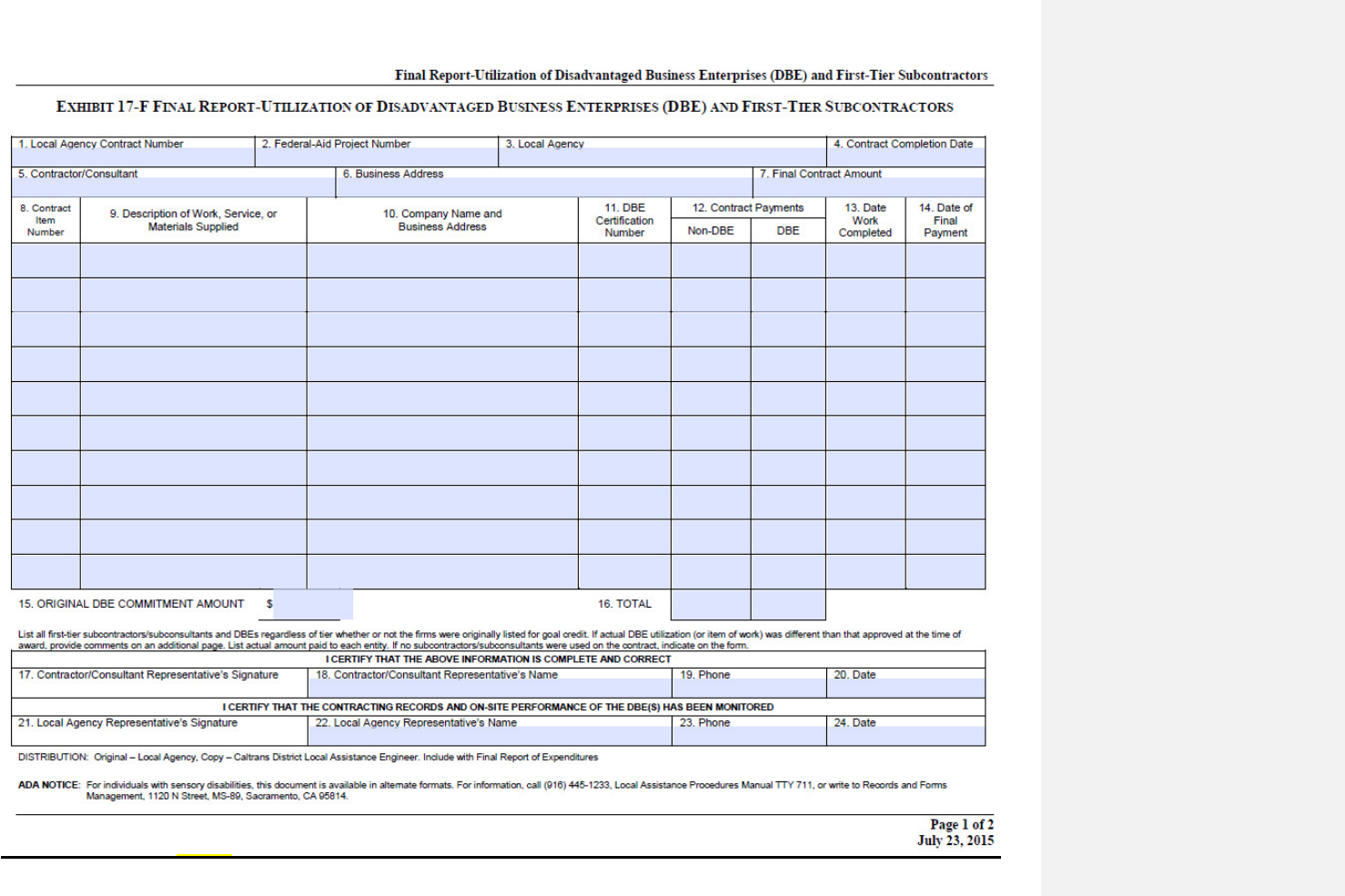
17-0XX-C1
60
Rev 10/14/16
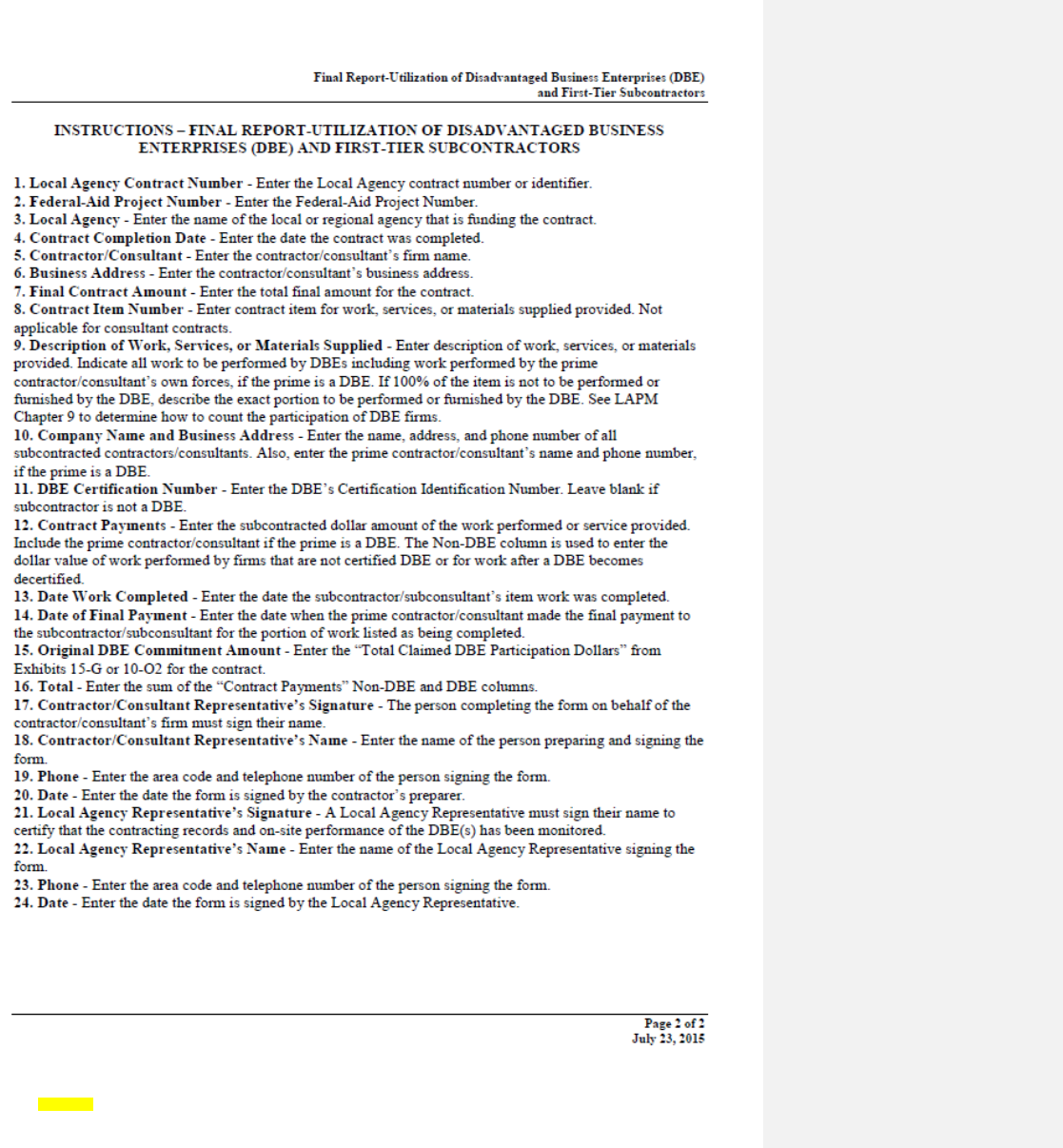
17-0XX-C1
61
Rev 10/14/16

17-0XX-C1
62
Rev 10/14/16
EXHIBIT K
Contract Amendment Request Form
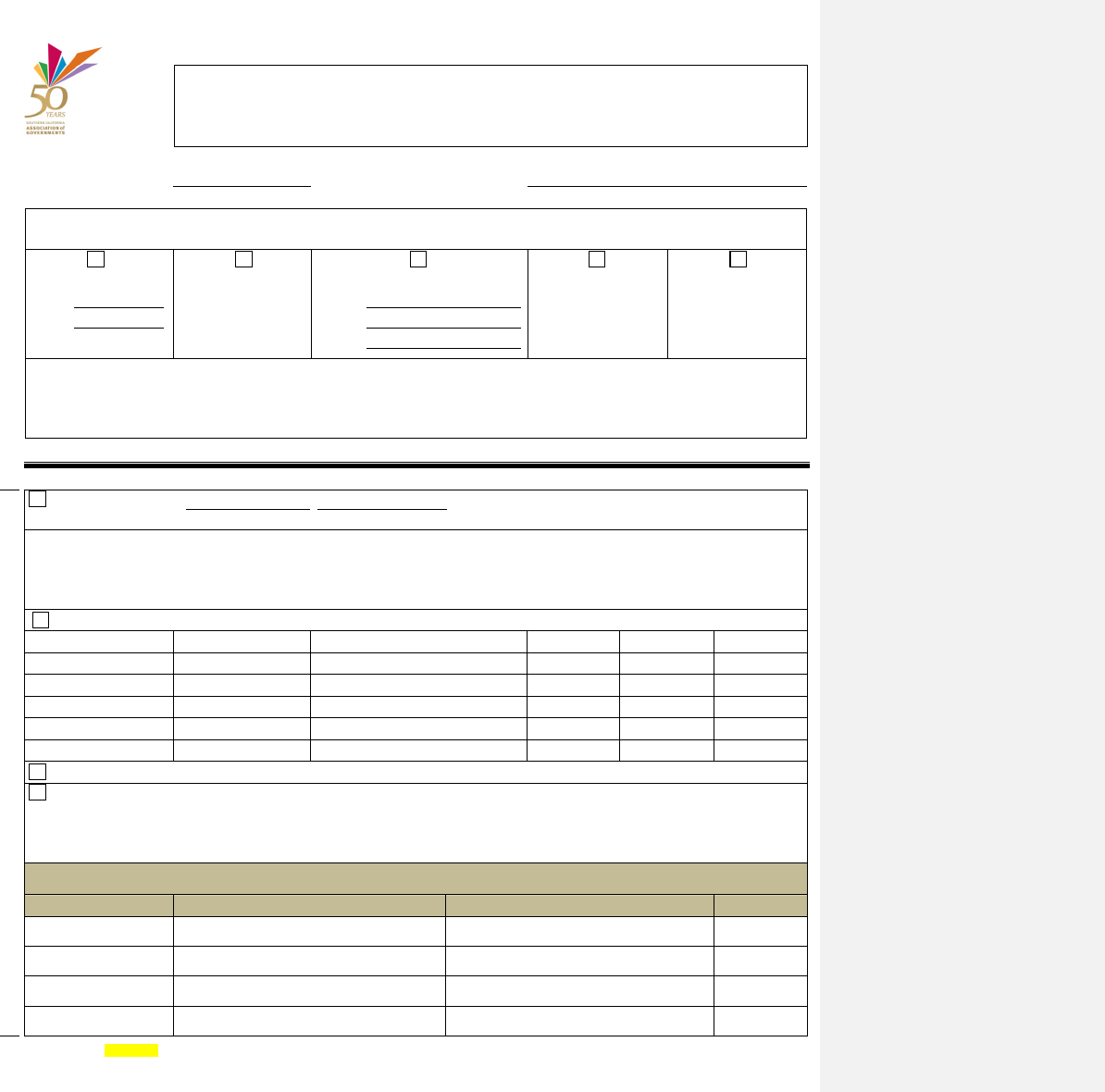
1
7
-
0XX
-
C1
63
Rev
10/14/16
Contract Amendment Request Form (Request)
Instructions:
Requestor to complete section
(if Requestor is the SCAG Project Manager, complete section
and
) and
email this Request to
the SCAG Contract Administrator, who will confirm receipt via email and provide further instructions. This Request only initiates
the amendment process. SCAG must still approve an actual Contract Amendment (Amendment) that shall not become effective
without the full execution by the Parties. Such Amendment shall become effective no earlier than the date that SCAG received
this Request. SCAG shall disallow any and all costs incurred by the Consultant prior to the effective date of an Amendment
resulting from this Request.
SCAG Contract No.:
17-0xx-xx
Consultant:
Item(s) Requested to be Changed:
(check all that apply and provide justification):
Contract Term
Line Item Budget
Project Manager
Scope of Work
Other
From:
(Price Sheet/Rate Structure) New Name:
(Specify -
To:
For changes to: Phone #:
in Justification
)
D/L
,
ODCs
or
Subs
Email:
Justification
(attach additional sheet, if necessary):
For SCAG Use Only
Contract Amoun
t:
$
$
(Only
SCAG P
M can request this)
From
To
Justification
- attach any supporting documentation, if applicable, with this Form, (i.e., correspondences between Consultant and SCAG PM
)
:
Funding:
Project Number(s) Cost Category Funding Source (FHWA/FTA/TDA)
% Fiscal Year Amount
SCAG Project Manager:
From:
To:
Other
(specify and also provide justification )
:
Request Approval:
(Only required if the “Effective Date” is requested to be earlier than the date that the Contract Administrator received this Request)
Title Print Name
Signature
Date
Project Manager
Manager
Director
CFO Basil Panas
